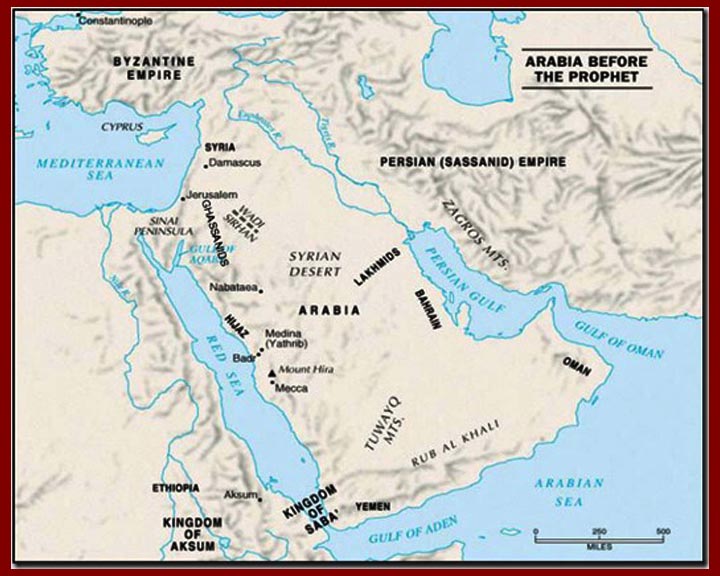Pre-Islam
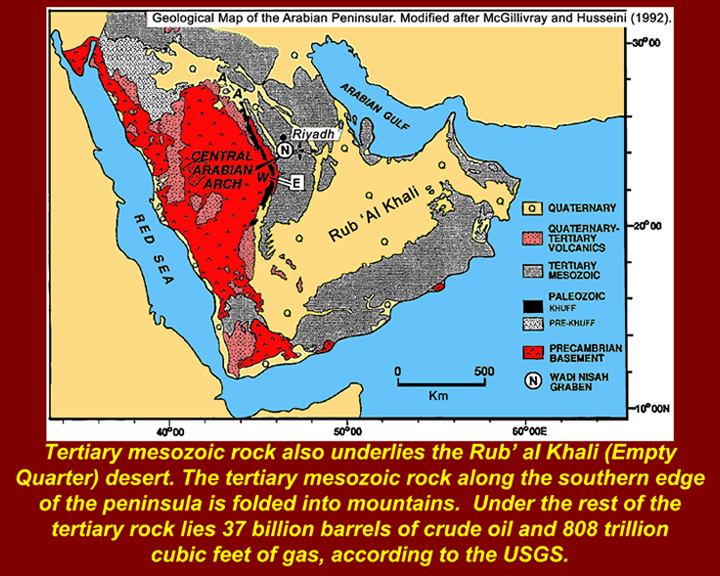
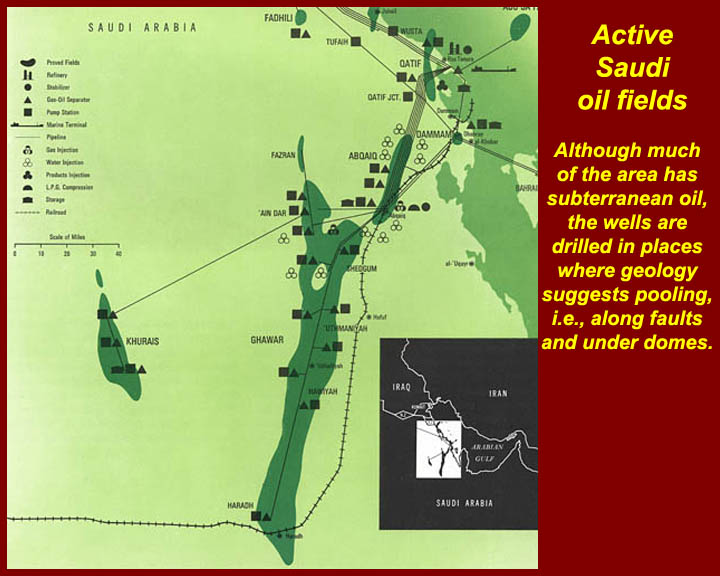
http://www.mmdtkw.org/CRUS0101-GeologicalMapArabianPeninsula.jpg
http://www.mmdtkw.org/CRUS0102-SaudiOilfields.jpg
Islam sprang from the Arabian Peninsula in the 7th century AD.
Wealth derived from exploitation of crude oil under the Arabian Peninsula allow the Government of Saudi Arabia to promote and support Islam throughout the world today.
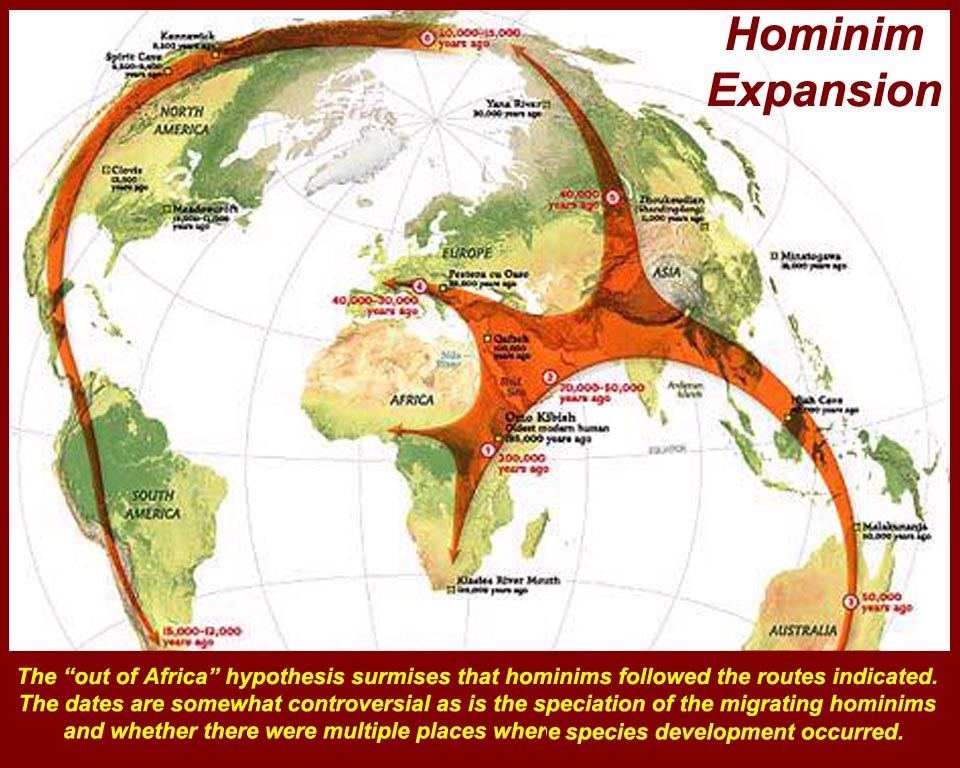
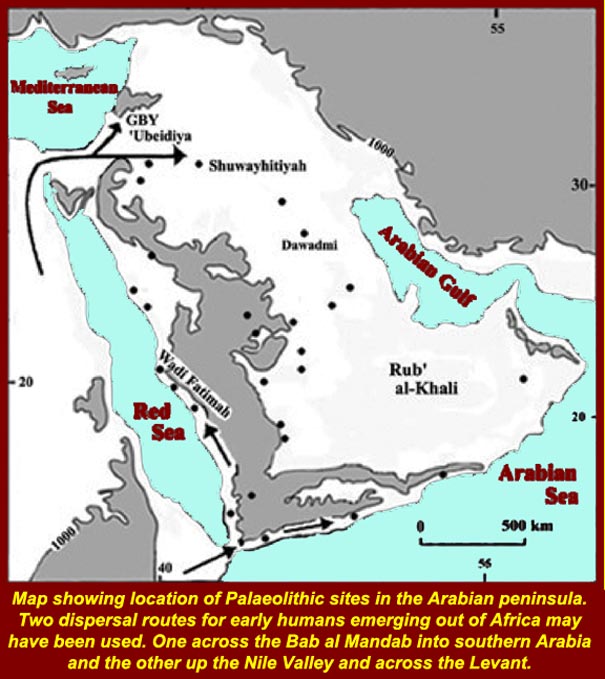
http://www.mmdtkw.org/CRUS0103-SpeciesExpansion.jpg
http://www.mmdtkw.org/CRUS0104-ArabPeninsulaOutIfAfric.jpg
The most commonly accepted theory of hominin (i.e., various species of homo) expansion posits movement through the Arabian Peninsula as shown in the first image above.
The second image shows the northern and southern supposed routes through Arabia in the "out of Africa" hypothesis
for the spread of homo species.
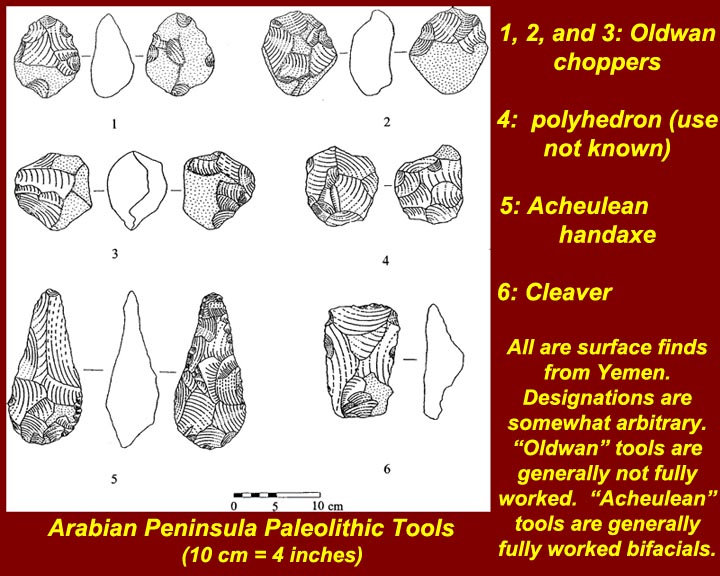
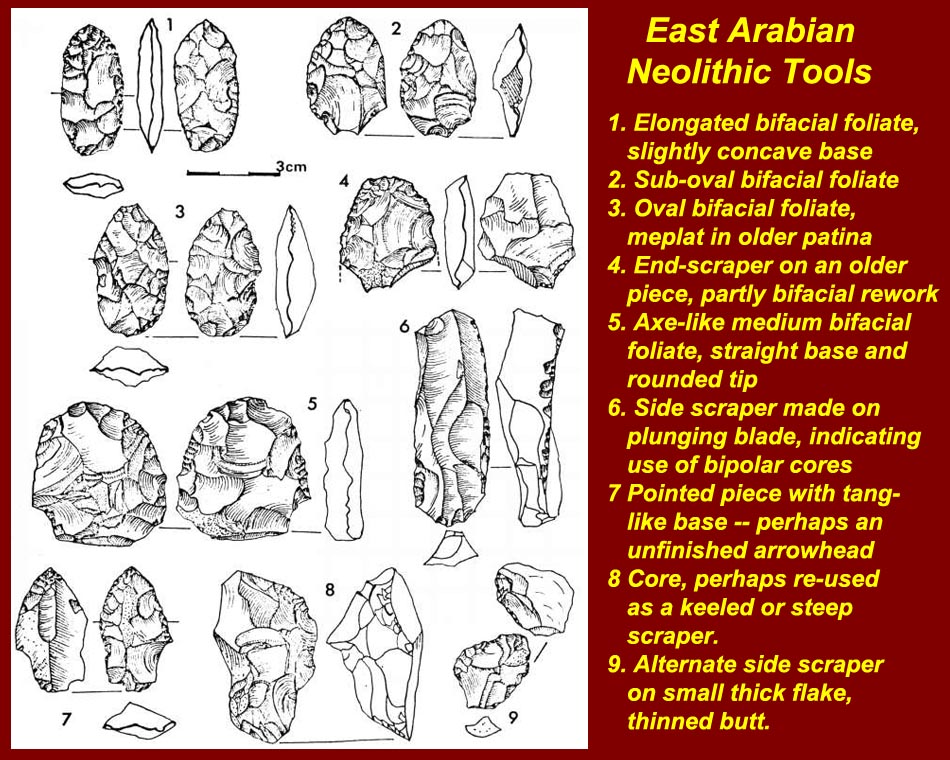
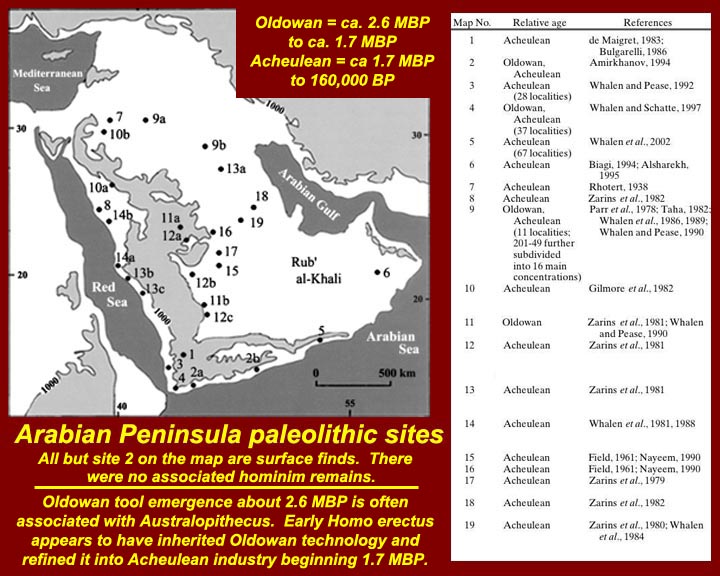
http://www.mmdtkw.org/CRUS0105-ArabPeninsulaPaleolithicTools.jpg
http://www.mmdtkw.org/CRUS0106-EastArabianNeolithicTools.jpg
http://www.mmdtkw.org/CRUS0107-SaudiPaleolithicMap.jpg
The "out of Africa - through the Arabian Peninsula" hypothesis is supported by the fact that some Paleolithic stone implements found in the at sites in the Arabian Peninsula are older than those found at any other sites outside of Africa.
Neolithic artifacts found in the Arabian Peninsula either were made by progeny of the early arrivals or were made by participants or progeny of participants of later waves of migration into or through the peninsula.
The map in the third image above show some of the relatively few paleolithic archeological sites that have been studied in the Arabian Peninsula. It is assumed that many other sites remain to be discovered and studied. All but two of the sites shown in the image had only surface finds -- in sandy areas of the world, wind tends to blow away soil leaving heavier artifacts on the surface. At some dry lake bed sites in the Rub' al-Khali surface finds are so common that they virtually constitute the entire surface.
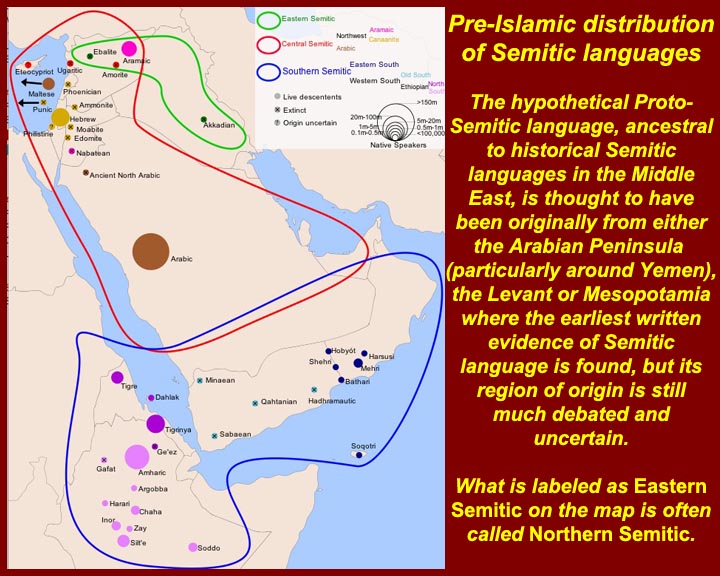
http://www.mmdtkw.org/CRUS0108-Pre-IslamicSemiticLanguages.jpg
All Semitic languages are assumed to be derived from some unknown proto-language which developed into three semitic linguistic families that were described/defined ex post facto by modern linguists. We should remember that this whole structure is simply a construct of the linguists that aids them in the study of modern languages of the area. In ancient times, the folks who spoke "proto-semitic" and its later variants simply learned from their parents, siblings, and neighbors, with whom they constructed and uttered conventional vocalizations which they combined with facial expressions, "body language", and gestures to convey meaning.
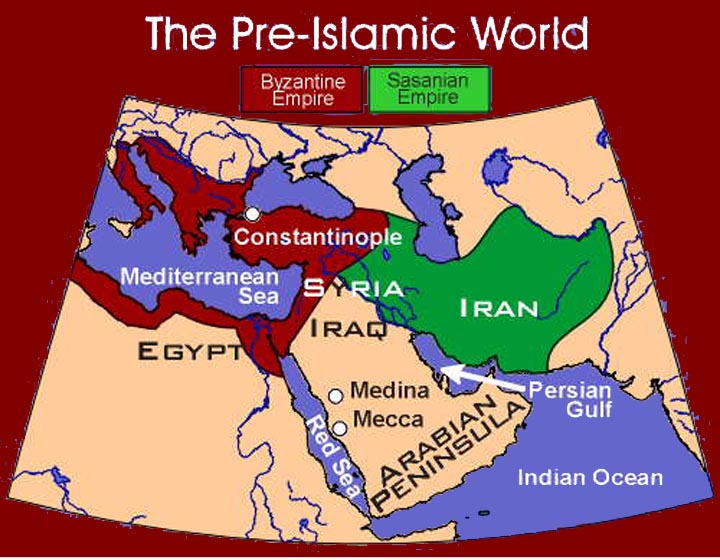
http://www.mmdtkw.org/CRUS0109-PreIslam.jpg
In pre-Islamic times, what we now know as the Middle-East was divided between the Byzatine and Sasanian empires, the latter of which was the last pre-Islamic Persian Empire. It was ruled by the Sasanian Dynasty from AD 224 to AD 651. The Sassanian Empire, which succeeded the Parthian Empire, was recognized as one of the main powers in Western, Southern, and Central Asia, alongside the Roman Empire and the Byzantine Empire, for a period of more than 400 years.
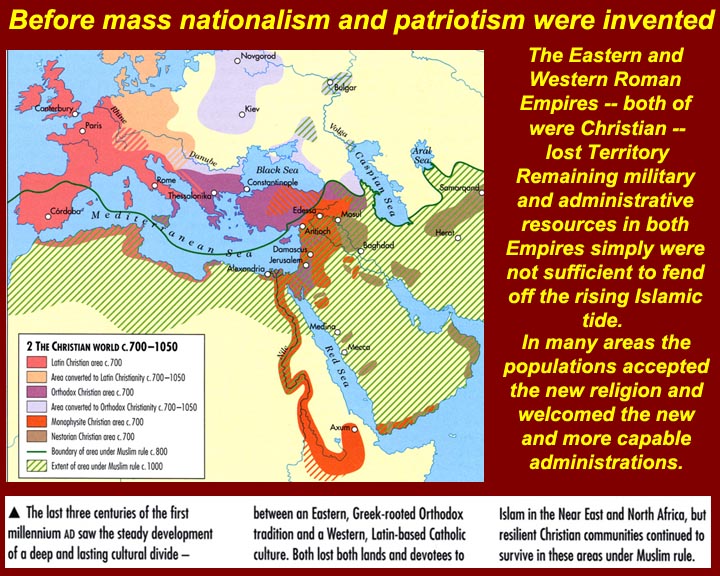
http://www.mmdtkw.org/CRUS0110-BeforeNationalism.jpg
Both the Eastern and Western Roman Empires lost territory to militant Islam, and that undoubtedly led to some (or even great) consternation in the upper echelons of the Imperial bureaucracy and in the military leadership. But nobody else had any great stake in the status quo. In fact, in many areas the Islamic "conquerors" appear to have been welcomed as salvation from the corrupt or at least inept administration of the previous rulers. Nationalism was still centuries away from its birth. Similarly, loyalty to the Christian religion had not been engendered by controversies among it various branches (which still today have not been settled). so the common people had little compunction in shifting to the apparently united and much more simple unitarian and monophysite belief structure and simple moral responsibilities of Islam.
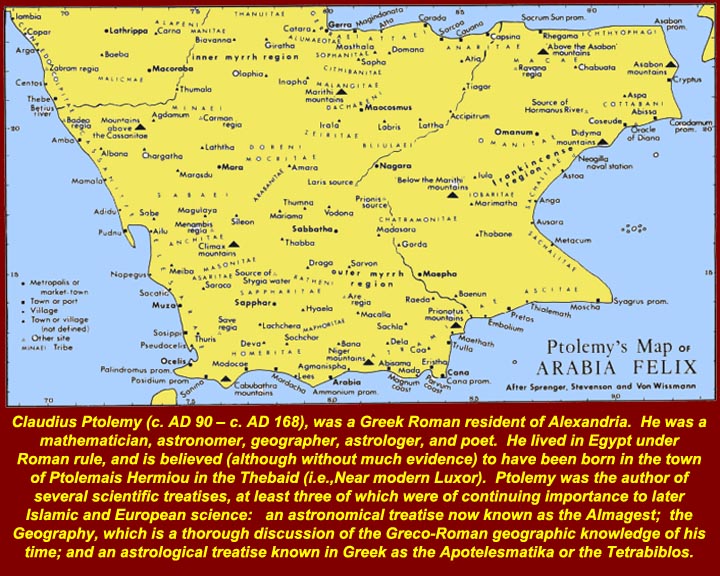
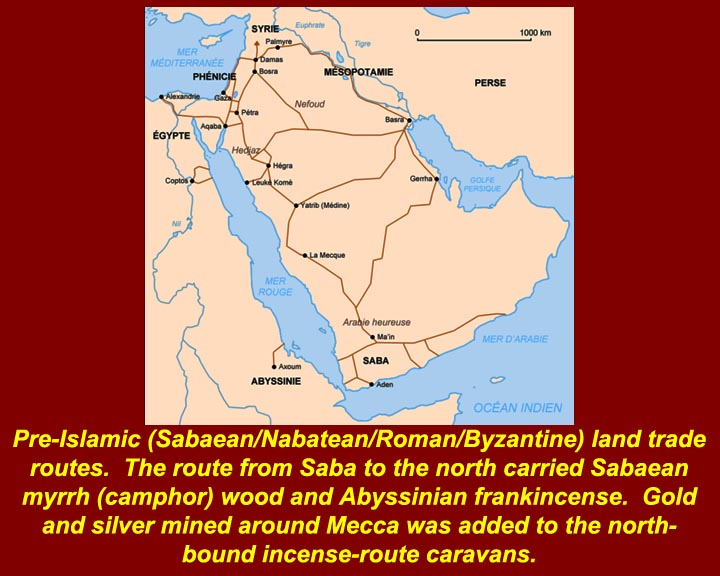
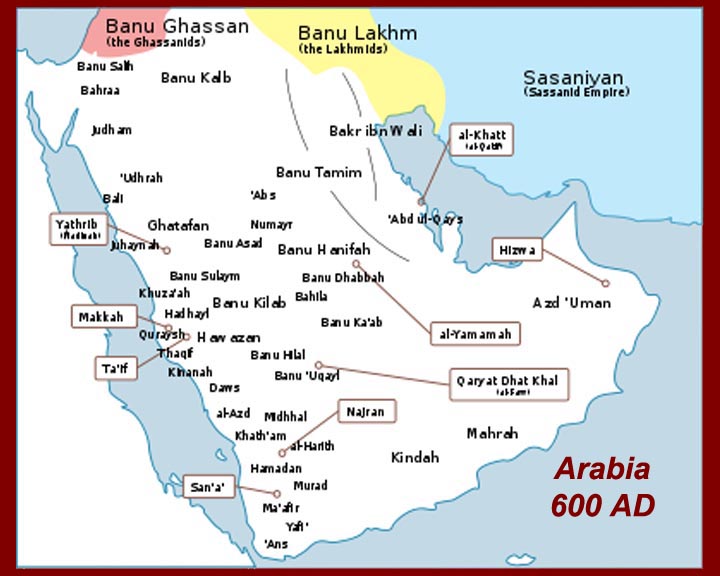
http://www.mmdtkw.org/CRUS0111-PtolemeyArabiaFelixMap.jpg
http://www.mmdtkw.org/CRUS0112-NabataeanTradeRoutes.jpg
http://www.mmdtkw.org/CRUS0114-TribesArabia600AD.jpg
Renaissance and even 18th and 19th century maps of the Arabian Peninsula deemed large areas of the peninsula's interior as unexplored. But already in the 2nd century The Greek Roman geographer Claudius Ptolemy had produced a credible map of the whole peninsula including the interior.
The interior of the peninsula was also well known to both the local tribal and royal leaderships and to the organizers of trade through the peninsula. None of the western explorers, of course, had the wit to ask the locals.
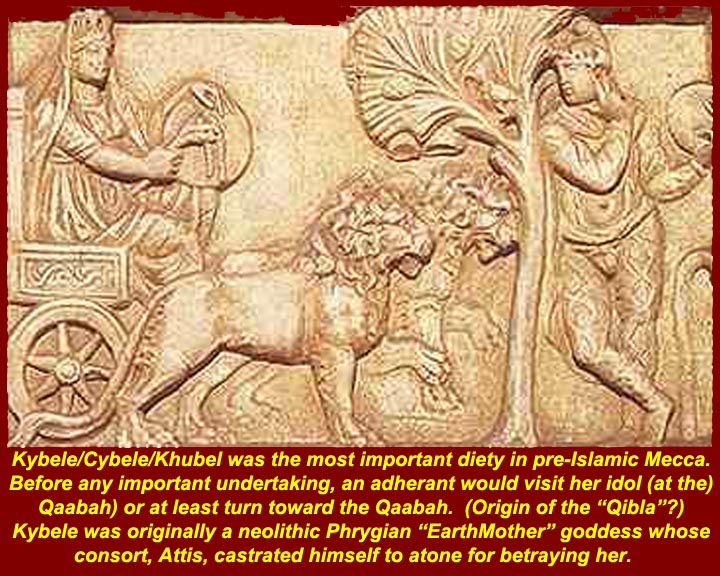
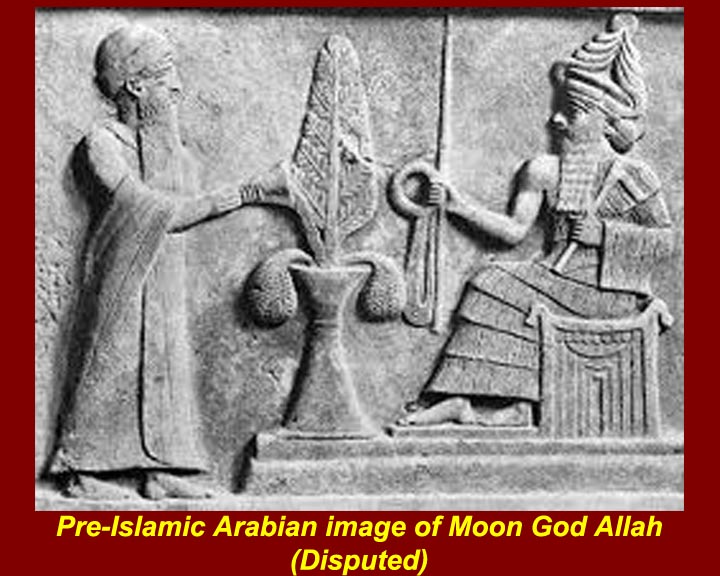
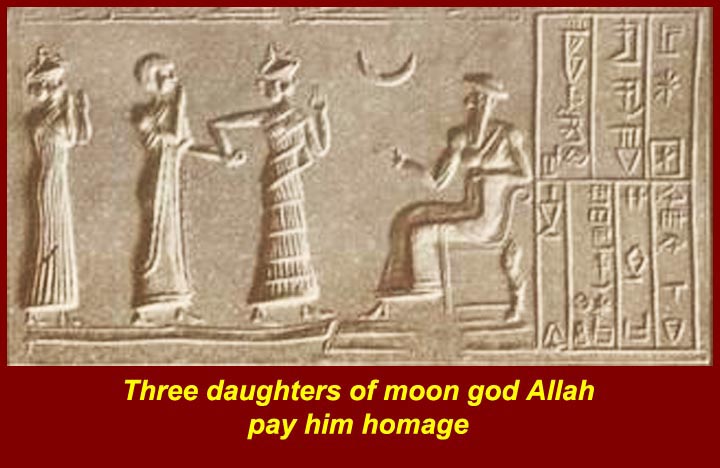
http://www.mmdtkw.org/CRUS0113-CybeleAttis.jpg
http://www.mmdtkw.org/CRUS0115-Pre-IslamicAllah1.jpg
http://www.mmdtkw.org/CRUS0115a-AllahThreeDaughters.jpg
Pagan images from the Hejaz (the western edge of the Arabian Peninsula) which included Mecca and Medina. The most important local goddess in Mecca was the earth goddess Cybele, to whom pre-Islamic Meccans turned for assistance before important decisions and actions. And by "turned" is meant visiting her idol in the Ka'bah or, at least, turning to face in the direction if the person was unable to physically visit the idol. Some scholars speculate that turning in the direction of Cybele is the origin of the Islamic qiblah, i.e., facing toward Mecca during prayer, (= Arabic: salih). The second and third images represent the pre-Islamic Allah, a moon god who was recognized as superior to (and in some areas creator of) all the other god and goddesses.
The pre-Islamic tribes of the Hejaz were pagan, but they were surrounded by areas inhabited by Christians and Jews. For further explication, see http://dharmaraja.blogspot.com/2010/06/before-beginning-al-jahiliyyah.html from which the text and image below is drawn
| Arabia in the 6th Century CE was a land on the
fringe of the great civilisations of the time. To its
north were the empires of Byzantium and Sassanid Persia.
In the south, in what is today Yemen were the ancient
city-states Saba, Maʿīn, Qataban, Hadramauth and Himyar,
that had links of trade, culture and perhaps kinship
across the Red sea with the Christian Kingdom of Aksun
(Abyssinia/ Ethiopia). In the north were the Bedouin
tribes of the Ghassanids and Lakhmids – who served as
clients for the Byzantines and Persians respectively.
And along the mountainous Red sea coast of western
Arabia, was the Hejaz or al-Hijaz, region of the great
caravan-trading Bedouin tribes, united under the
mercantile aristocracy of the tribe of Quraysh, with the
sanctuary in Mecca as its spiritual centre. The religious landscape of the peninsula was similarly diverse. The Arabs of the Hejaz were ‘pagans’, but the Ghassinids were monophysite Christians, the Lakhnids too, though they served the Persians, followed Christianity, probably Nestorian. The peoples of south-western Arabia were probably multi-religious – pagans, Jews and monophysite-Christian. In fact, according to some sources, the last Himyarite king in the Yemen region, Dhū Nuwās, converted to Judaism and began persecuting the Christian population, who appealed to the Byzantines for aid. The Byzantines arranged for the Christian Kingdom of Aksun to send an army under the general Abraha into Yemen. Abraha deposed Dhū Nuwās and became Governor. He is believed to have constructed a great Church at Sana'a and sought to extend his influence into the Hejaz to which purpose he led an army that included elephants against Mecca. According to Arab tradition the city was miraculously saved. This is said to have happened in the year of the Prophet’s birth (CE 570), which perhaps to commemorate this miracle, is known as “the year of the elephant”. In any case, this Christian kingdom of Yemen is believed to have ended after the Sassanids launched a counter-intervention and expelled the Ethiopians. |
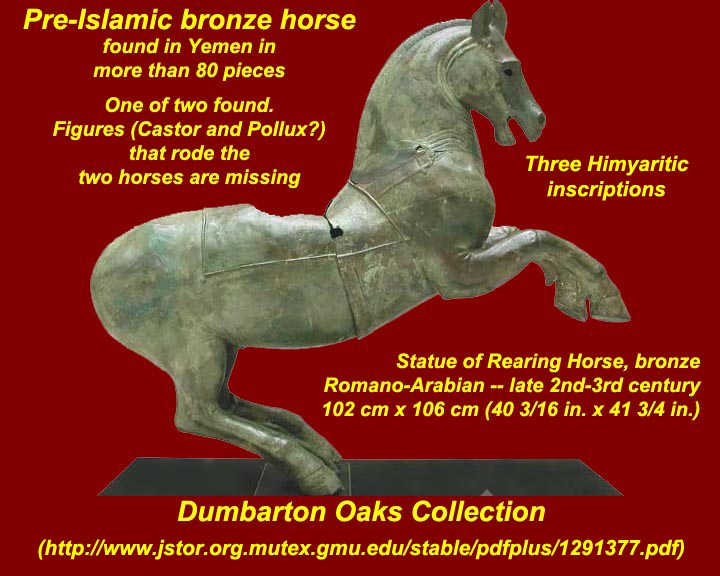
http://www.mmdtkw.org/CRUS0116-DumbartonBronzeHorse.jpg
The Roman bronze horse (now at Dumbarton Oaks in Washington DC) is one of many Roman artifacts recovered in Yemen. Rome had extensive contacts with Arabia in pre-Islamic times starting almost immediately after the conquest of Egypt by Augustus in 30 BC. An two legion expedition into Arabia led by the second prefect of Roman Egypt, Aelius Gallus, was recorded by the historian and geographer Strabo. Strabo, whose source was Aelius, said the effort ended in failure, due to heat, lack of (or bad) water, treachery of a guide, and logistics failures. See http://en.wikipedia.org/wiki/Romans_in_Arabia and internal links in that article and a translation of Strabo's account at http://penelope.uchicago.edu/Thayer/E/Roman/Texts/Strabo/16D*.html for more detail. The Romans called the northwest section of the Arabian Peninsula Arabia Petraea, the central area Arabia Deserta, and the southwest section Arabia Felix.
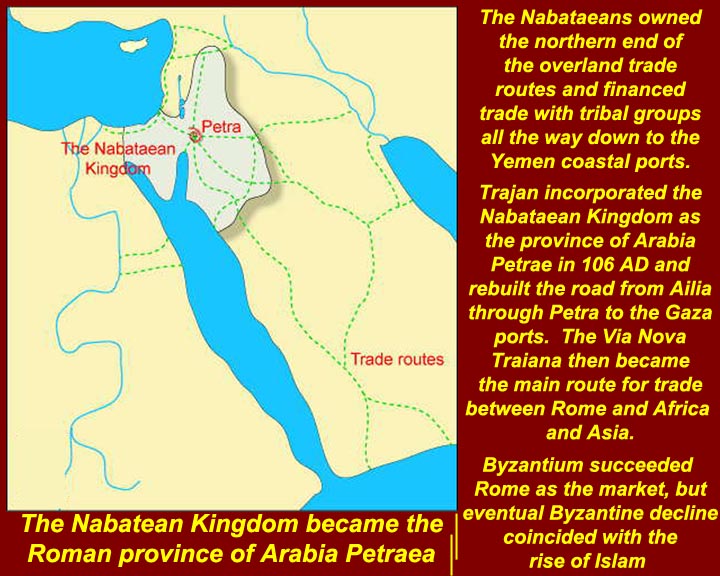
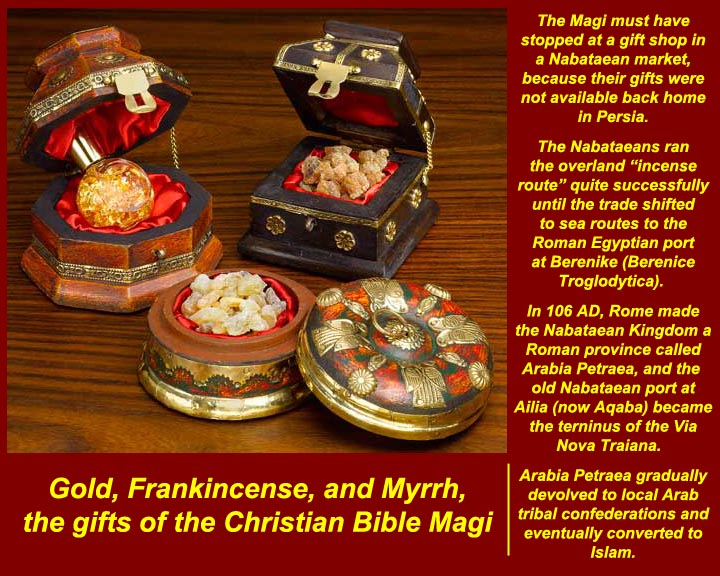
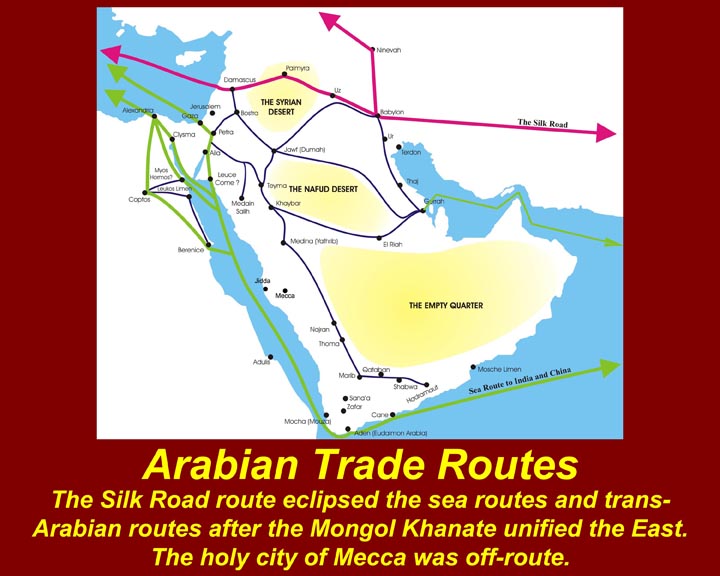
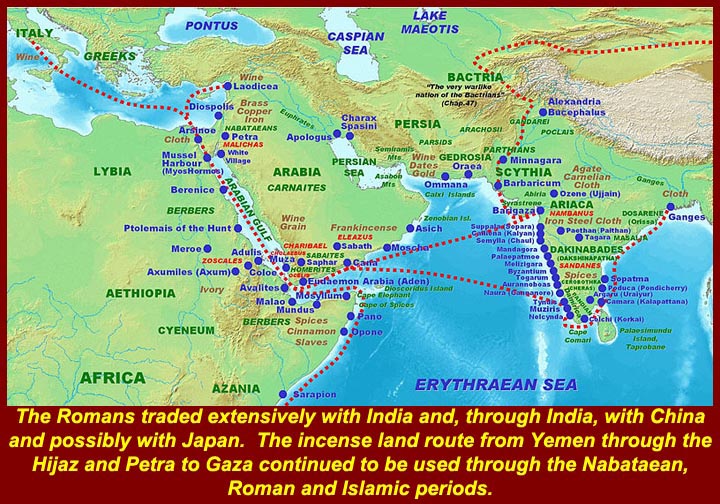
http://www.mmdtkw.org/CRUS0117-NabataeanTrade.jpg
http://www.mmdtkw.org/CRUS0118-Frankincense-and-Myrrh.jpg
http://www.mmdtkw.org/CRUS0118a-ArabianTradeRoutes.jpg
http://www.mmdtkw.org/CRUS0118aa-RomeIndiaTrade.jpg
The Nabataean Kingdom encompassed the northern end of the overland "incense" route. In 106 AD, Trajan's legions took over Nabataea and renamed it Arabia Petraea. The conquest was not strongly opposed as evidenced by the fact that Nabataean military forces almost immediately were absorbed in the the Roman military machine as auxiliaries. Both the Nabataenans and, in turn, the Romans maintained strong links with tribes to the south and with successive Yemeni administrations. Everyone involved recognized the mutual benefits of keeping open the overland route, which carried east African and Yemeni aromatics northward.
The center section of the route was controlled by the Quraysh tribe centered in Mecca and was the source of Quraysh wealth and power. Mohamad's first wife, Khadija bint Khuwaylid, was a wealthy merchant of the Quraysh. Mohamad's biography indicates that, as a youth, he participated trade caravans on the incense route as far north as Syria and that later in life he was involved in trade between India and the Mediterranean. (A short summary of generally accepted information about Mohamad is available at http://en.wikipedia.org/wiki/Muhammad.)
Although sea routes to Berenice on the Red Sea coast of Roman Egypt and then to Ailia (Roman Aqaba) eventually took over trade from India and further east, the overland incense route continued to be important well into the Islamic period.
---------------------------------------
Mohamed and the beginnings of Islam
To expand images, click on the small images or on the links immediately below small images.
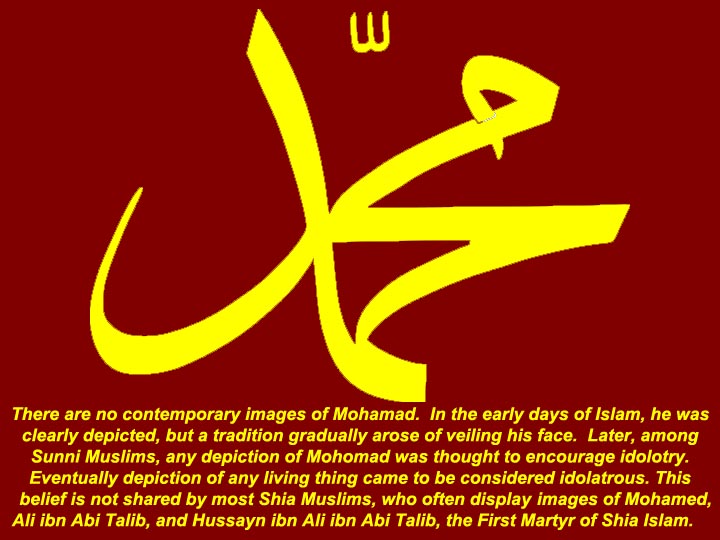
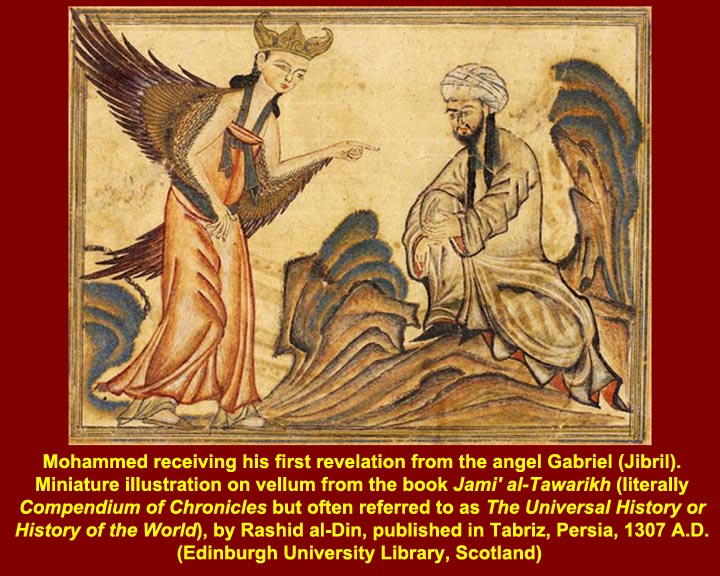
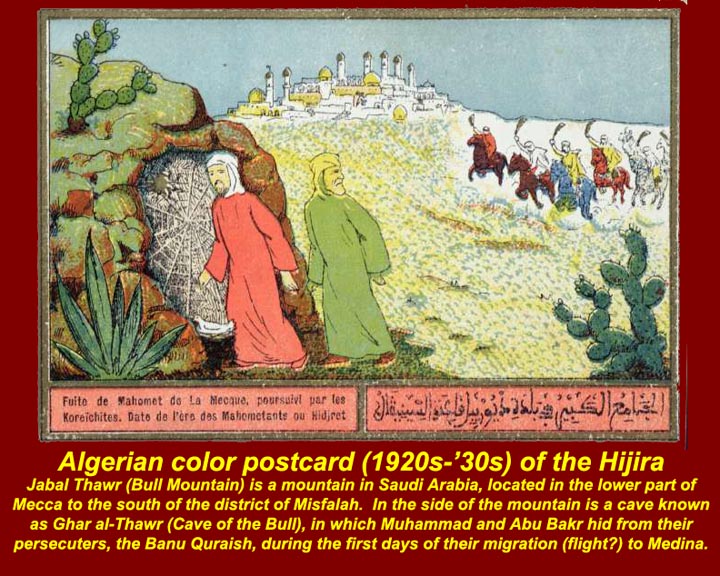
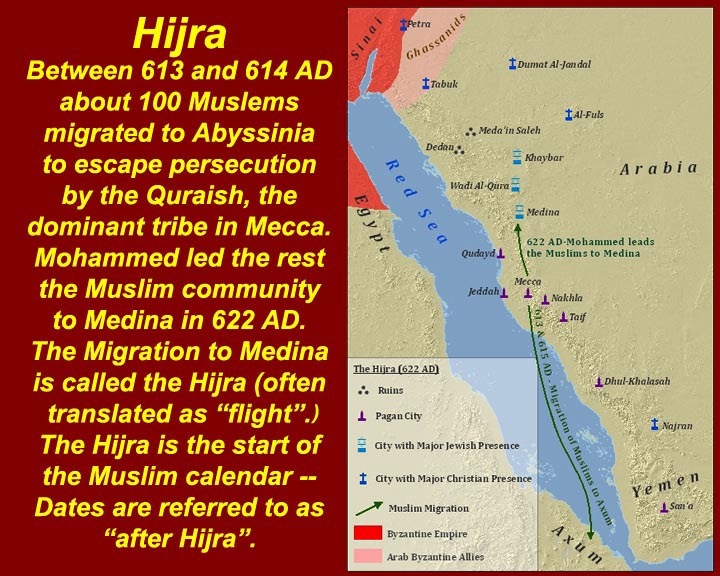
http://www.mmdtkw.org/CRUS0118b-MohamedArabic.jpg
http://www.mmdtkw.org/CRUS0119-Mohamed-Gabriel.jpg
http://www.mmdtkw.org/CRUS0120-JabalThawrCave.jpg
http://www.mmdtkw.org/CRUS0120a-Hijra622.jpg
Images of Mohamed are are no longer condoned by most Sunni Muslims, who consider such images to be temptations to idolatry. Instead, an image of his name in Arabic script -- often the one shown -- is used to represent him. The aversion to images of Mohamed was not a feature of early Islam. Two examples are shown, the first of Mohamed receiving his first revelation from the angel Gabriel (Jibril) and the second of Mohamed and Abu Bakr seeking refuge from their Quraysh enemies in the Cave of the Bull near Mecca at the beginning of the hijra.
The Hijra (or Hejira) was the movement of of Mohamed and his followers from Mecca to Yathrib in 622 AD to escape persecution by the Quraysh. The Quraysh leadership apparently were jealous of Mohamed's growing influence. Mohamed was welcomed by in Yathrib where his following grew. In 630 Mohamed leading a force of his followers (as many as 10,000 in some accounts) returned triumphantly to Mecca, converted the Quraysh, and destoyed the idols in and around the Ka'bah.
Shia Muslims generally do not share Sunni aversion to images of Mohamed -- images of Mohamed, Ali, and Hussayn are often displayed in by Shia Muslims.
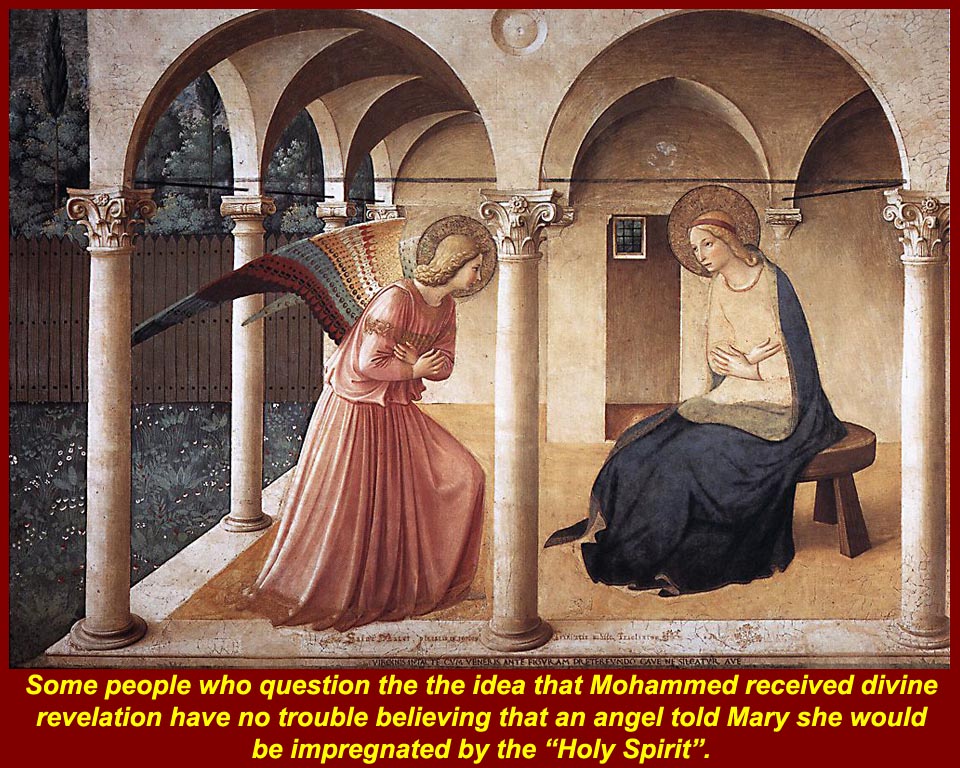
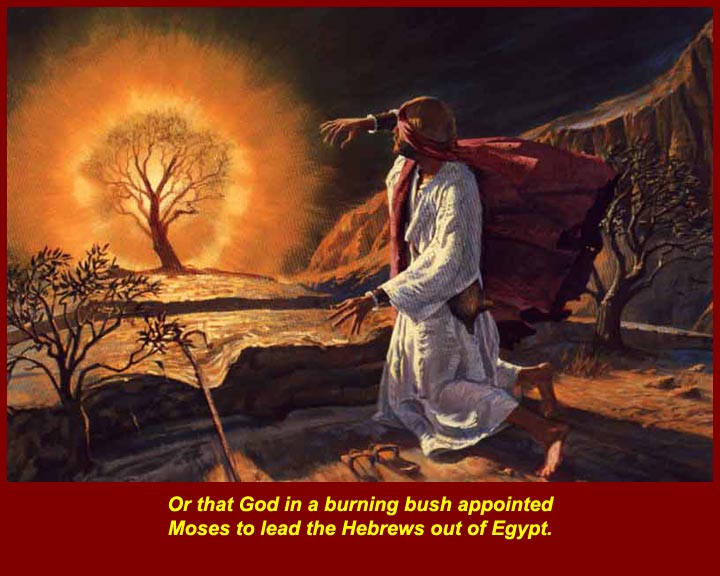
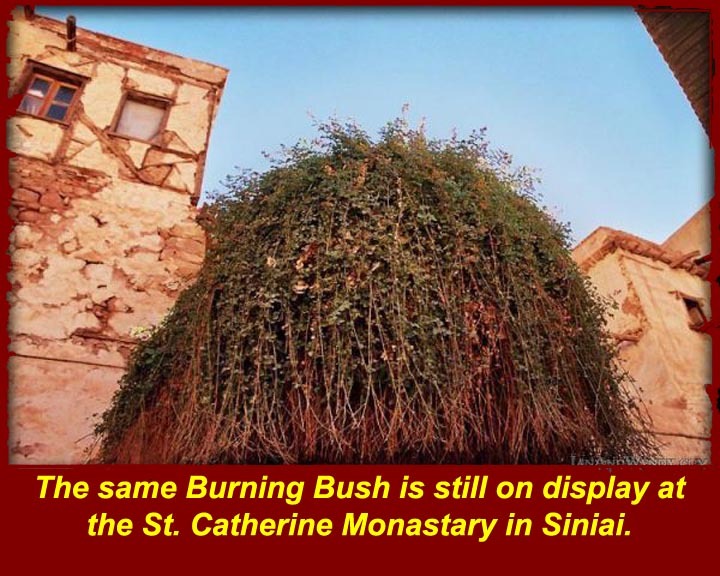
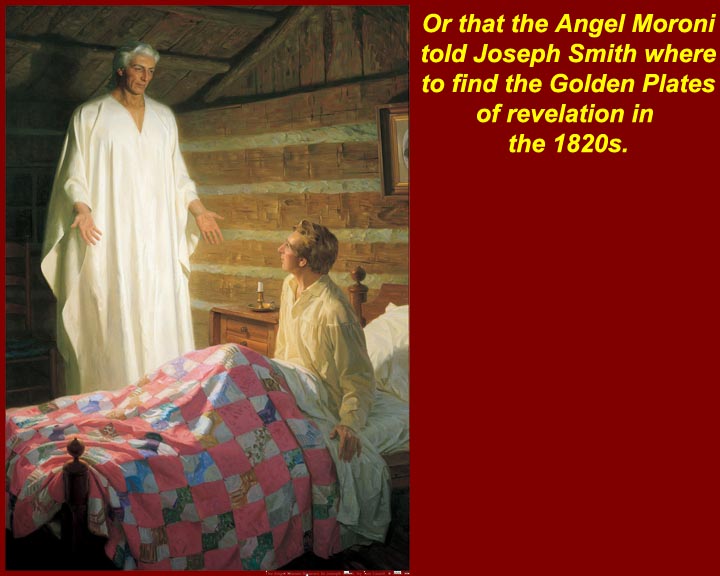
http://www.mmdtkw.org/CRUS0121-Annunciation.jpg
http://www.mmdtkw.org/CRUS0122-MosesBurningBush.jpg
http://www.mmdtkw.org/CRUS0123-BurningBushStCatherine.jpg
http://www.mmdtkw.org/CRUS0124-Moroni-JosephSmith.jpg
Non-Muslims may doubt the authenticity of revelations to Mohamed but have no problem accepting revelation in their own cults. Shown are images of the Christian Annunciation, Jewish Burning Bush (and the bush, which is still growing at St. Catherine's monastery in the Siniai), and the Mormon revelation to Joseph Smith by the angel Moroni.
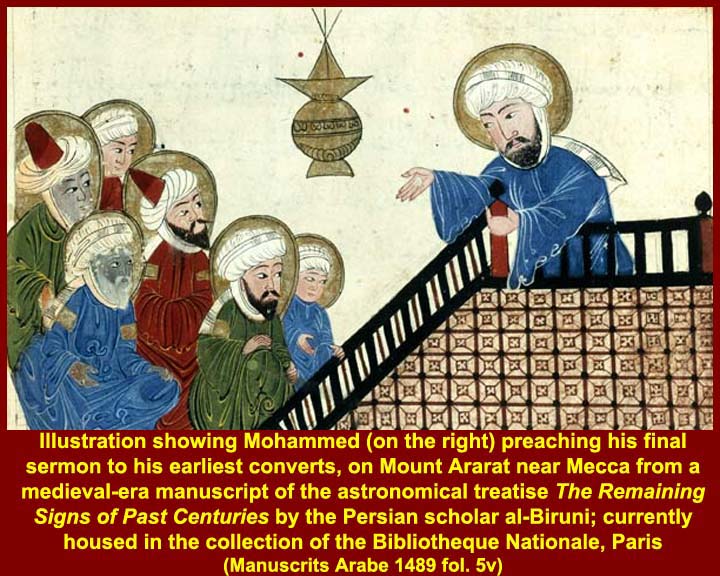
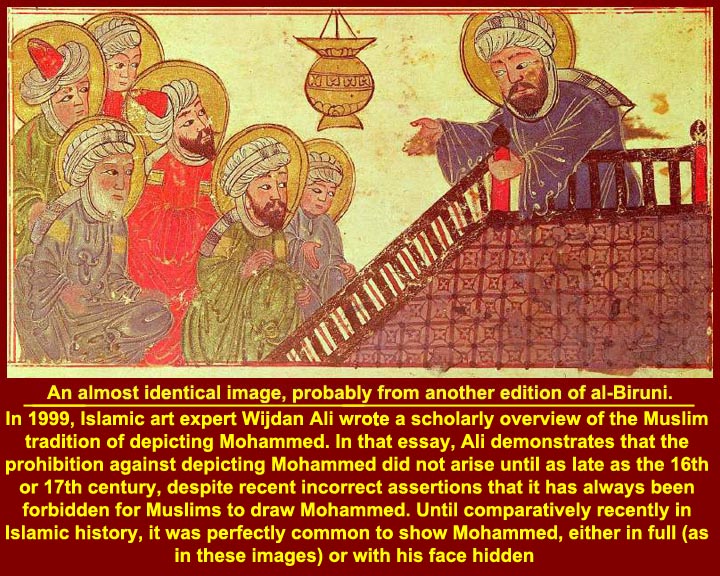
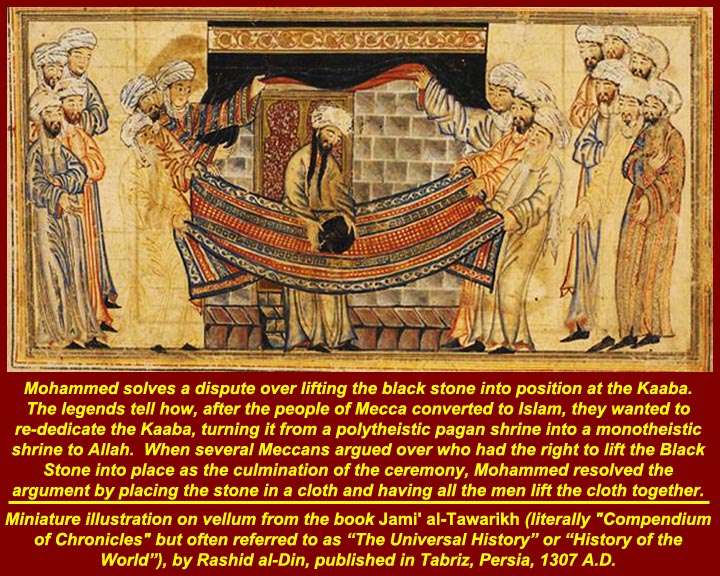
http://www.mmdtkw.org/CRUS0125-Mohammed-AlBiruni1Paris.jpg
http://www.mmdtkw.org/CRUS0126-Mohammed-AlBiruni2Edinb-13thC.jpg
http://www.mmdtkw.org/CRUS0127-MohammedStone.jpg
Two images (probably from different editions of Al Biruni's Vestiges of Past Centuries, written ca. 1000 AD and still in print in various editions and languages) show Mohamed delivering his last sermon on Mt. Arafat in Mecca. The third image show a pre-revelation Mohamed mediating a dispute among Meccan leaders over who would re-install the Black Stone after the Ka'bah was refurbished. His solution was to have all the leaders carry the stone in a cloth to its position in the corner of the Ka'bah.
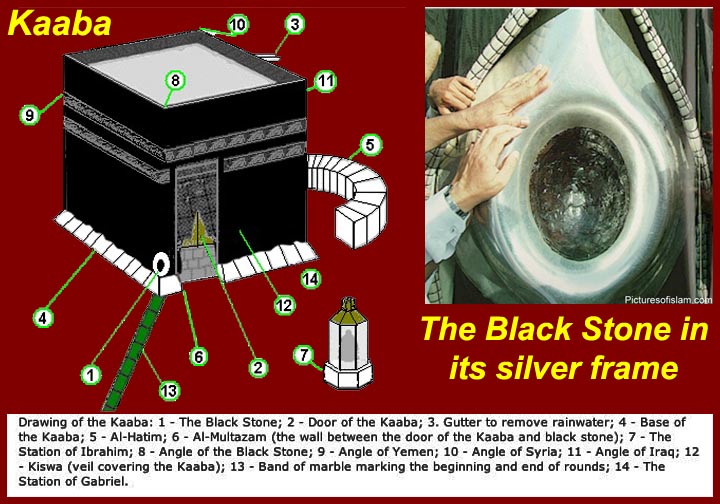
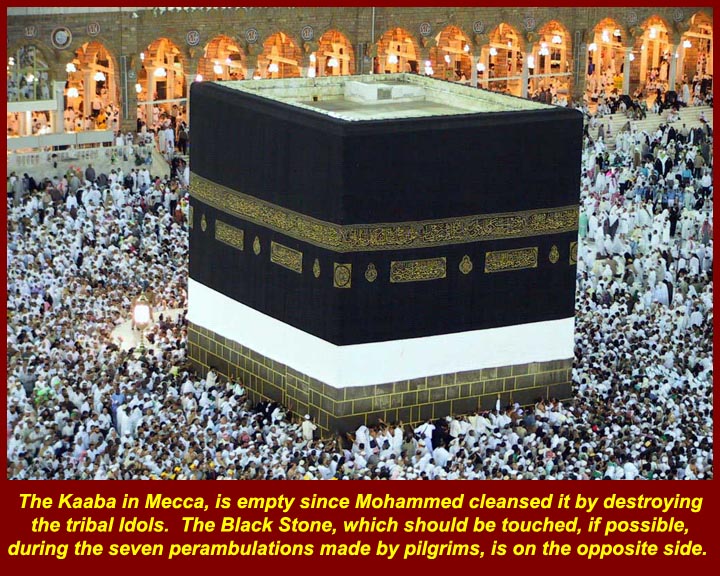
http://www.mmdtkw.org/CRUS0128-KaabaDiagram.jpg
http://www.mmdtkw.org/CRUS0129-Kaabah.jpg
The Qur'an states that the Ka'bah in the Masjid al Haram (the "Sacred Mosque") in the center of Mecca was built by Abraham and his son Ismail. The Black Stone is in a silver frame in the eastern corner of the ka'bah.
For an short explanation of the Ka'bah, see http://en.wikipedia.org/wiki/Kaaba.
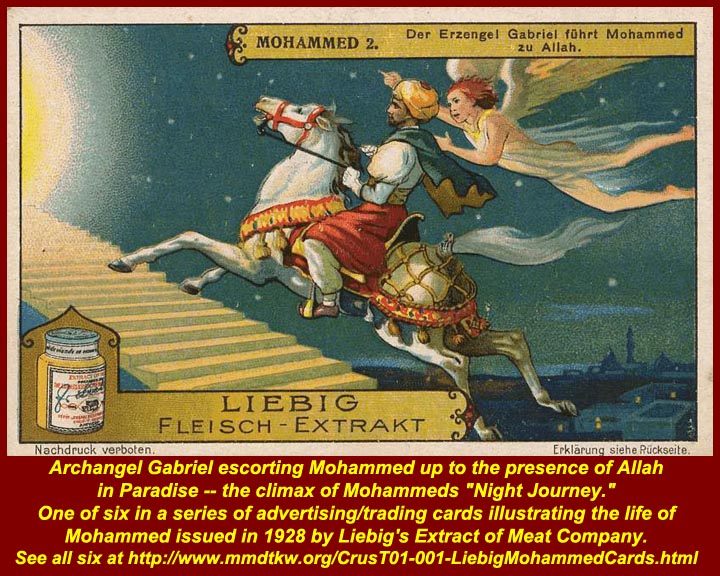
http://www.mmdtkw.org/CRUS0130-NightJourney.jpg
Perhaps the most important image in this unit, this is a representation of Mohamed's Night Journey, riding on Buraq to the Farthest Mosque.
The Islamic assertion that location of the Farthest Mosque is in Jerusalem is, and has been in the past, the basis for the Islamic territorial claim for Jerusalem. For western secularists this claim has little basis, but we should remember that other claims for Jerusalem were and are based on similar tenuous religious assertions.
According to most Islamic reckonings, Mohamed's Night Journey (al-isra w' al-mi'raj) took place shortly before the hijra, which would place it in or around 621 AD. Muhammad al-Bukhari in the Sahih al-Bukhari describes Mohamed's mount, an animal called Buraq: "...a white animal which was smaller than a mule and bigger than a donkey was brought to me." ... "The animal's step (was so wide that it) reached the farthest point within the reach of the animal's sight. ..." Al-isra was Mohamed's journey to the earthly "farthest mosque" and al-mi'raj was the subsequent journey of Mohamed to heaven where he conversed with Allah. (For an explanation of the Night Journey, see http://en.wikipedia.org/wiki/Isra_and_Mi'raj and for information on the Sahih al Bukhari hadith collection, see http://en.wikipedia.org/wiki/Sahih_al-Bukhari. Further information can be found by following links on these pages.)
From very early in the Islamic period, the "farthest mosque" has been identified with the site of the Aqsa mosque in Jerusalem. The earliest Muslim qiblah (direction of prayer) was toward Jerusalem.
According to the traditional Muslim view, the Qiblah originally faced the Noble Sanctuary in Jerusalem. This Qiblah was used for over 13 years, from 610 CE until 623 CE. Seventeen months after the Islamic prophet Muhammad's 622 CE arrival in Medina – the date is given as 11 February 624 – the Qiblah became oriented towards the Kaaba in Mecca. According to traditional accounts from Muhammad's companions, the change happened very suddenly during the noon prayer in Medina, in a mosque now known as Masjid al-Qiblatain (Mosque of the Two Qiblahs). Muhammad was leading the prayer when he received revelations from God instructing him to take the Kaaba as the Qiblah (literally, "Turn then Thy face in the direction of the sacred Mosque:"). According to the traditional accounts contained in the hadith and sira, Muhammad, who had been facing Jerusalem, upon receiving this revelation, immediately turned around to face Mecca, and those praying behind him also did so. (From http://en.wikipedia.org/wiki/Qibla.)Al-Aqsa mosque in Jerusalem is built at the site claimed by Islam of the Farthest Mosque, and the name al-Aqsa literally means, in Arabic, "the farthest". The Dome of the Rock which is the other major structure in the "Noble Sanctuary" (Judeo-Christian "Temple Mount"), covers the stone peak on which Abraham is said to have prepared to sacrifice his son (Isaac in the Judeo-Christian tradition and Ismail in the Muslim tradition.) Guides at the Dome of the Rock also point to indentations in the rock as the footprints of Mohamed where he stood to begin al-mi'raj.
Note that Persian and far eastern Islamic representations of Mohamed's Night Journey sometimes show Mohamed's mount as a horse with a female human head and a peacock tail. See for example http://zombietime.com/mohammed_image_archive/islamic_mo_face_hidden/buraqflame.jpg.
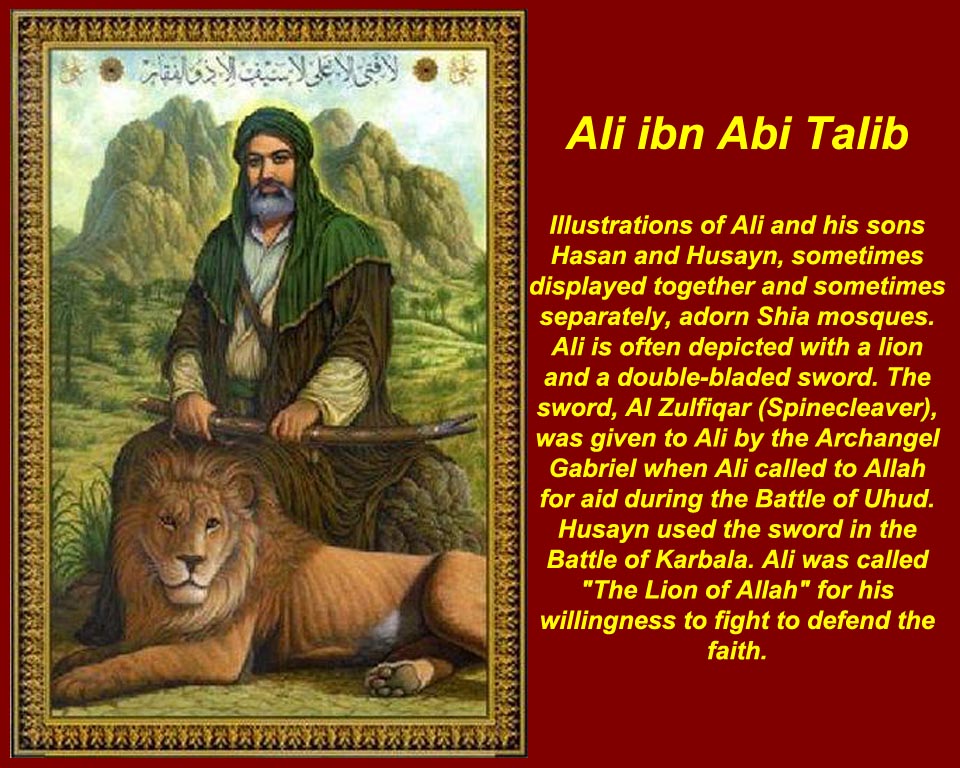
http://www.mmdtkw.org/CRUS0130a-Ali.jpg
Ali ibn Abi Talib was the son of Mohamed's uncle,Abu Talib. Ali, the cousin and son-in-law of Islamic prophet Muhaed, ruled over the Islamic Caliphate from 656 to 661, and was the first male convert to Islam. Sunni Muslims consider Ali the fourth and final of the Rashidun ("rightly guided" Caliphs), while Shias regard Ali as the first Imam and consider him and his descendants the rightful successors to Muhammad, i.e., members of the Ahl al-Bayt, the household of Muhammad. This disagreement split the Ummah (Muslim community) into the Sunni and Shia branches.
For More information on Ali, see http://en.wikipedia.org/wiki/Ali.
For more information on Sunni Islam, see http://en.wikipedia.org/wiki/Sunni_Islam.
For more information on Shia Islam, see http://en.wikipedia.org/wiki/Shia_Islam.
Follow links on thes pages for further information.
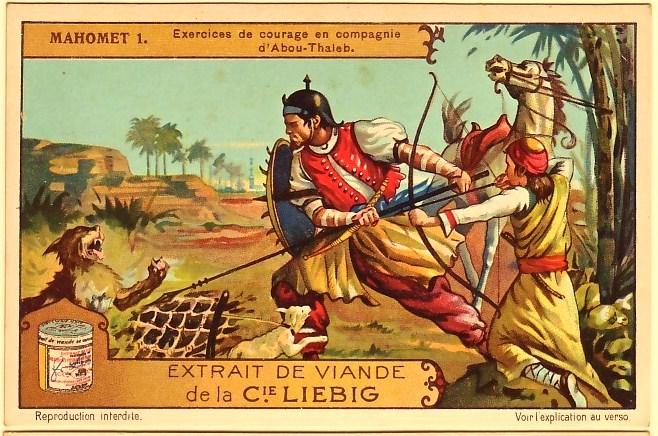
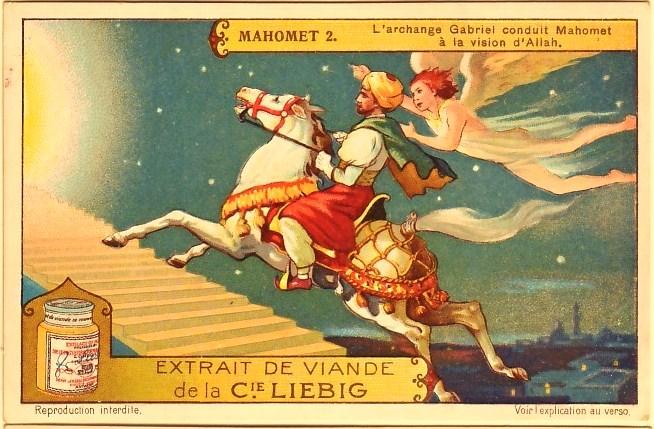
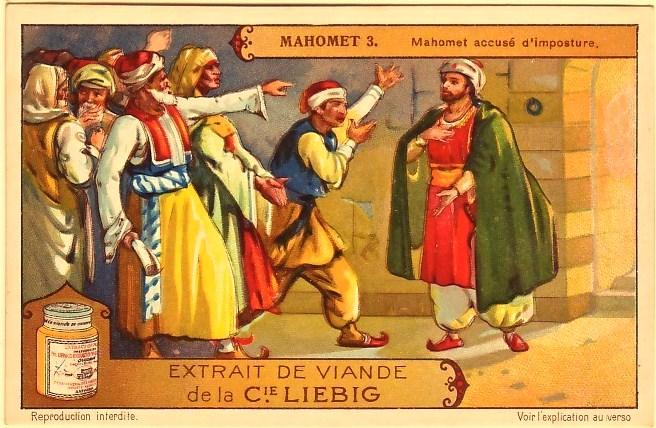
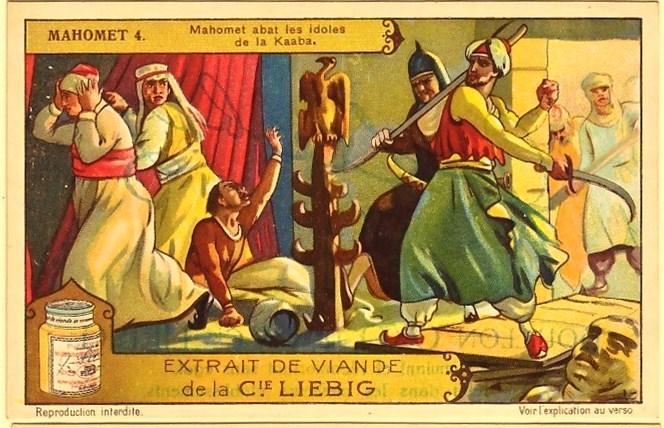
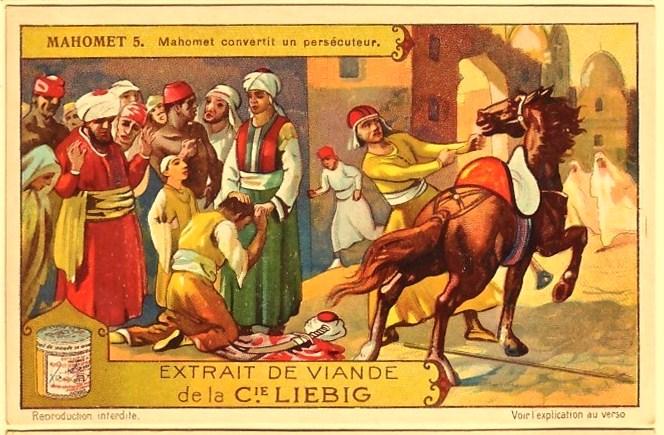
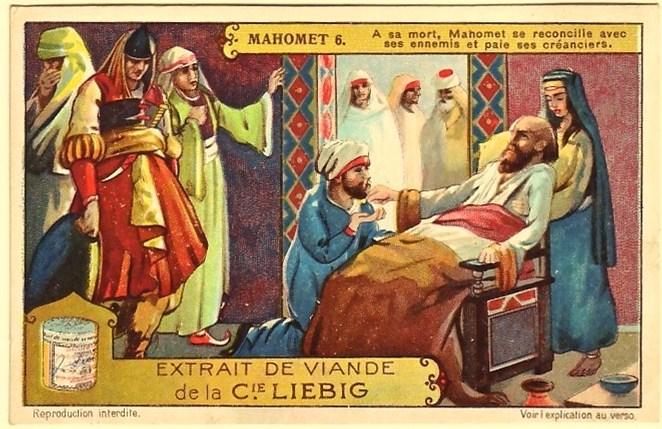
http://www.mmdtkw.org/CRUS0131-ExercisesDeCourage.jpg
http://www.mmdtkw.org/CRUS0132-GabrielConduitMahomet.jpg
http://www.mmdtkw.org/CRUS0133-MahometAccuse.jpg
http://www.mmdtkw.org/CRUS0134-MahometAbatLesIdoles.jpg
http://www.mmdtkw.org/CRUS0135-MahometConvertit.jpg
http://www.mmdtkw.org/CRUS0136-MahometASaMort.jpg
Because new images of Mohamed have become increasingly rare, images of incidents in his life sometimes are available only from rather strange sources. An archive of Mohamed images is available on the Internet at http://zombietime.com/mohammed_image_archive/. Since there are no known contemporary images if Mohamed, all later images are simply artists' guesses about how he may have appeared. WARNING -- some of the images in the archive will certainly offend Muslims.
The images above are a series of six advertizing trading cards issued by the Liebig Extract of Meat Company (Lemco) . (The Liebig's company was the originator of Liebig and Oxo meat extracts and later Oxo beef stock cubes. It was named after Baron Justus von Liebig, the German 19th-century organic chemist who founded it.)
-----------------------------
The Spread of Islam -- Conquest/Jihad
From http://atheism.about.com/library/FAQs/christian/blchron_xian_crusades01.htm
Launched by Pope Urban
II at the Council of Clermont in
1095, the First Crusade was the most successful. Urban gave
a dramatic speech
urging Christians to swarm towards Jerusalem and make it
safe for Christian
pilgrims by taking it away from the Muslims. The armies of
the First Crusade
left in 1096 and captured Jerusalem in 1099. From
these conquered lands
Crusaders carved out small kingdoms for themselves which
endured for some time,
though not long enough to have a real impact upon local
culture.
|
Timeline of the
Crusades: Before the Crusades 350 - 1095 |
|
|
0355 |
After removing a Roman
temple from the site (possibly the Temple of
Aphrodite built by Hadrian), Constantine I
has the Church of the Holy Sepulcher constructed in
Jerusalem.
Built around the excavated hill of the Crucifixion,
legend has it that Constantine's mother Helena
discovered the True Cross here. |
|
0613 |
Persians capture
Damascus and Antioch. |
|
0614 |
Persians sack Jerusalem.
damaging the Church of the Holy Sepulcher in the
process. |
|
0633 |
|
|
0634 - 0644 |
Umar (c. 0591 - 0644)
reigns as the second caliph. |
|
0635 |
Muslims begin the
conquest of Persia and Syria. |
|
0635 |
Arab Muslims capture
the city of Damascus from the Byzantines. |
|
August 20, 0636 |
Battle of Yarmuk (also: Yarmuq,
Hieromyax): Following the Muslim capture of Damascus
and Edessa, Byzantine
Emperor Heraclius organizes a large army which
manages to take back control of those cities.
However, Byzantine commander, Baänes is soundly
defeated by Muslim forces under Khalid ibn Walid in
a battle in the valley of the Yarmuk River outside
Damascus. This leaves all of Syria open to
Arab domination. |
|
0637 |
The Arabs occupy the
Persian capital of Ctesiphon. By 0651, the entire
Persian realm would come under the rule of Islam and
continued its westward expansion. |
|
0637 |
Syria is
conquered by Muslim forces. |
|
0637 |
Jerusalem falls
to invading Muslim forces. |
|
0638 |
|
|
0639 |
Muslims conquer Egypt and
Persia. |
|
0641 |
Islam spreads into Egypt. The
Catholic Archbishop invites Muslims to help free
Egypt from Roman oppressors. |
|
0641 |
Under the leadership of
Abd-al-Rahman, Muslims conquer southern areas of
Azerbaijan, Daghestan, Georgia, and Armenia. |
|
0641 |
Under the leadership of
Amr ibn al-As, Muslims conquer the Byzantine city
of Alexandria in Egypt. Amr
forbids the looting of the city and proclaims
freedom of worship for all. According to some
accounts, he also has what was left of the Great
Library burned the following year. Al-As creates the
first Muslim city in Egypt, al-Fustat, and builds
there the first mosque in Egypt. |
|
0644 |
Muslim leader Umar dies
and is succeeded by Caliph Uthman, a member of the Umayyad family
that had rejected Muhammad's prophesies. Rallies
arise to support Ali, Muhammad's
cousin and son-in-law, as caliph. Uthman launches
invasions to the west into North Africa. |
|
0649 |
Muawiya I, a member of
the Umayyad family, leads a raid against Cyprus,
sacking the capital Salamis-Constantia after a short
siege and pillaging the rest of the island. |
|
0652 |
Sicily is attacked by
Muslims coming out of Tunisia (named Ifriqiya by the
Muslims, a name later given to the entire continent
of Africa). |
|
0653 |
Muawiya I leads a raid
against Rhodes, taking the remaining pieces of the
Colossus of Rhodes (one of the Seven Wonders of the
ancient world) and shipping it back to Syria to be
sold as scrap metal. |
|
0654 |
Muawiya I conquers
Cyprus and stations a large garrison there. The
island would remain in Muslim hands until 0966. |
|
0655 |
Battle of the Masts: In one of the only
Muslim naval victories in the entire history of
Islam, Muslim forces under the command of Uthman bin
Affan defeat Byzantine
forces under Emperor Constant II. The battle takes
place off the coast of Lycia and is an important
stage in the decline of Byzantine power. |
|
0661 - 0680 |
Mu'awiya, founder of the
Umayyad
dynasty, becomes the caliph and moves the capital
from Mecca to Damascus. |
|
0662 |
Egypt fell to
the Umayyad and Abbasid caliphates until 868 CE. A
year prior, the Fertile Crescent and Persia yielded
to the Umayyad and
Abbasid caliphates, whose rule lasted until 1258 CE
and 820 CE, respectively. |
|
0667 |
Sicily is attacked by
Muslims coming out of Tunisia. |
|
0668 |
First Siege of Constantinople:
This attack lasts off and on for seven years, with
the Muslim forces generally spending the winters on
the island of Cyzicus, a few miles south of
Constantinople, and only sailing against the city
during the spring and summer months. The Greeks are
able to fend off repeated attacks with a weapon
desperately feared by the Arabs: Greek Fire. It
burned through ships, shields, and flesh and it
could not be put out once it started. Muawiyah has
to send emissaries to Byzantine
Emperor Constans to beg him to let the survivors
return home unimpeded, a request that is granted in
exchange for a yearly tribute of 3,000 pieces of
gold, fifty slaves, and fifty Arab horses. |
|
0669 |
The Muslim conquest
reaches to Morocco in North Africa. The region would
be open to the rule of the Umayyad and Abbasid
caliphates until 800 CE. |
|
0672 |
Muslims under Mauwiya I
capture the island of Rhodes. |
|
0674 |
Arab conquest reaches
the Indus River. |
|
August 23, 0676 |
Birth of Charles Martel
(Charles the Hammer) in Herstal, Wallonia, Belgium,
as the illegitimate son of Pippin II. Serving as
Mayor of the Palace of the kingdom of the Franks,
Charles would lead a force of Christians that turn
back a Muslim raiding party near Poitiers (or Tours)
which, according to many historians, would
effectively halt the advance of Islam against
Christianity in the West. |
|
0677 |
Muslims send a large
fleet against Constantinople in an effort to finally
break the city, but they are defeated so badly
through the Byzantine use of Greek Fire that they
are forced to pay an indemnity to the Emperor. |
|
0680 |
Birth of Leo III the
Isaurian, Byzantine Emperor, along the
Turkish-Syrian border in the Syrian province of
Commagene. Leo's tactical skills would be
responsible for turning back the second Arab Muslim
siege of Constantinople
in 0717, shortly after he is elected emperor. |
|
0688 |
Emperor Justinian II and
Caliph al-Malik sign a peace treaty making Cyprus
neutral territory. For the next 300 years, Cyprus is
ruled jointly by both the Byzantines and the Arabs
despite the continuing warfare between them
elsewhere. |
|
0691 |
Birth of Hisham, 10th
caliph of the Umayyad
Dynasty. It is under Hisham that Muslim forces would
make their deepest incursions into Western Europe
before being stopped by Charles Martel
at the Battle of Poitiers in 0732. |
|
0698 |
Muslims capture Carthage
in North Africa. |
|
0700 |
Muslims from
Pamntelleria raid the island of Sicily. |
|
0711 |
With the further
conquest of Egypt, Spain
and North Africa, Islam included all of the Persian
empire and most of the old Roman world under Islamic
rule. Muslims began the conquest of Sindh in Afghanistan. |
|
April 0711 |
Tariq ibn Malik, a
Berber officer, crosses the strait separating Africa
and Europe with a group of Muslims and enters Spain
(al-Andalus, as the Muslims called it, a word is
etymologically linked to "Vandals"). The first stop
in the Muslim conquest of Spain is at the foot of a
mountain that comes to be called Jabel Tarik, the
Mountain of Tarik. Today it is known as Gibraltar.
At one time the Berbers had been Christians but they
recently converted in large numbers to Islam after
the Arab conquest of North Africa. |
|
July 19, 0711 |
Battle of Guadalete: Tariq ibn Ziyad kills
King Rodrigo (or Roderic), Visigoth ruler of Spain,
at the Guadalete River in the south of the Iberian
peninsula. Tariq ibn Ziyad had landed at Gibraltar
with 7,000 Muslims at the invitation of heirs of the
late Visigoth King Witica (Witiza) who wanted to get
rid of Rodrigo (this group includes Oppas, the
bishop of Toledo and primate of all Spain, who
happens to be the brother of the late king Witica).
Ziyad, however, refuses to turn control of the
region back over to the heirs of Witica. Almost the
entire Iberian peninsula would come under Islamic
control by 0718 CE. |
|
0712 |
Muslim governor of
Northern Africa Musa ibn Nusayr follows Tariq ibn
Ziyad with an army of 18,000 as reinforcements for
the conquest of Andalusia. Musa's father had been a
Catholic Yemenite studying to be a priest in Iraq when he
was captured in Iraq by Khalid, the "Sword of
Islam," and forced to choose between conversion or
death. This invasion of Iraq had been one of the
last military orders given by Muhammed before his
death. |
|
0714 |
Birth of Pippin III
(Pippin the Short) in Jupille (Belgium). Son of Charles Martel
and father of Charlemagne, in
0759 Pippin would capture Narbonne, the last Muslim
stronghold in France, and thereby drive Islam out of
France. |
|
0715 |
By this year just about
all of Spain is in Muslim hands. The Muslim conquest
of Spain only took around three years but the
Christian reconquest would require around 460 years
(it might have gone faster had the various Christian
kingdoms not been at each other' throats much of the
time). Musa's son, Abd el-Aziz, is left in charge
and makes his capital the city of Seville, where he
married Egilona, widow of king Rodrigo. Caliph
Suleiman, a paranoid ruler, would have el-Aziz
assassinated and sends Musa into exile in his native
Yemen village to live out his days as a beggar. |
|
0716 |
Lisbon is captured by
Muslims. |
|
0717 |
Cordova (Qurtuba)
becomes the capital of Muslim holdings in Andalusia
(Spain). |
|
0717 |
Leo the Isaurian, born
along the Turkish-Syrian border in the Syrian
province of Commagene, revolts against the usurper
Theodosius III and assumes the throne of the
Byzantine Empire. |
|
August 15, 0717 |
Second Siege of Constantinople:
Taking advantage of the civil unrest in the Byzantine
Empire, Caliph Sulieman sends 120,000 Muslims under
the command of his brother, Moslemah, to launch the
second siege of Constantinople. Another force of
around 100,000 Muslims with 1,800 galleys soon
arrives from Syria and Egypt to
assist. Most of these reinforcements are quickly
destroyed with Greek Fire. Eventually the Muslims
outside Constantinople begin to starve and, in the
winter, they also begin to freeze to death. Even the
Bulgarians, usually hostile to the Byzantines, send
a force to destroy Muslim reinforcements marching
from Adrianopolis. |
|
August 15, 0718 |
Muslims abandon
their second siege of Constantinople.
Their failure here leads to the weakening of the Umayyad
government, in part because of the heavy losses. It
is estimated that of the 200,000 soldiers who
besieged Constantinople, only around 30,000 made it
home. Although the Byzantine
Empire also sustains heavily casualties and loses
most its territory south of the Taurus Mountains, by
holding the line here they prevent a disorganized
and militarily inferior Europe from having to
confront a Muslim invasion along the shortest
possible route. Instead, the Arabic invasion of
Europe must proceed along the longer path across
northern Africa and into Spain, a route which
prevents quick reinforcement and ultimately proves
ineffective. |
|
0719 |
Muslims attack
Septimania in southern France (so named because it
was the base of operations for Rome's Seventh
Legion) and become established in the region known
as Languedoc, made famous several hundred years
later as the center of the Cathar heresy. |
|
July 09, 0721 |
A Muslim army under the
command of Al-Semah and that had crossed the
Pyrenees is defeated by the Franks near Toulouse.
Al-Semah is killed and his remaining forces, which
had previously conquered Narbonne, are forced back
across the Pyrenees into Spain. |
|
0722 |
Battle of Covadonga: Pelayo, (0690-0737)
Visigoth noble who had been elected the first King
of Asturias (0718-0737), defeats a Muslim army at
Alcama near Covadonga. This is generally regarded as
the first real Christian victory over the Muslims in
the Reconquista. |
|
0724 |
Hisham becomes the 10th
caliph of the Umayyad
Dynasty. It is under Hisham that Muslim forces make
their deepest incursions into Western Europe before
being stopped by Charles Martel
at the Battle of Poitiers in 0732. |
|
0724 |
Under the command of
Ambissa, Emir of Andalusia, Muslim forces raid
southern France and capture the cities of Carcassone
and Nimes. Primary targets in these and other raids
are churches and monasteries where the Muslims take
away holy objects and enslave or kill all the
clerics. |
|
0725 |
Muslim forces occupied
Nimes, France. |
|
0730 |
Muslim forces occupy the
French cities of Narbonne and Avignon. |
|
October 10, 0732 |
Battle of Tours: With perhaps 1,500 soldiers, Charles Martel
halts a Muslim force of around 40,000 to 60,000
cavalry under Abd el-Rahman Al Ghafiqi from moving
farther into Europe. Many regard this battle as
being decisive in that it saved Europe from Muslim
control. Gibbon wrote: "A victorious line of march
had been prolonged above a thousand miles from the
rock of Gibraltar to the banks of the Loire; the
repetition of an equal space would have carried the
Saracens to the confines of Poland and the Highlands
of Scotland; the Rhine is not more impassable than
the Nile or Euphrates, and the Arabian fleet might
have sailed without a naval combat into the mouth of
the Thames. Perhaps the interpretation of the Koran
would now be taught in the schools of Oxford, and
her pulpits might demonstrate to a circumcised
people the sanctity and truth of the revelation of
Muhammed." Others, though, argue that the battle's
importance has been exaggerated. The names of Tours,
Poitiers, and Charles Martel do not appear in the
Arab histories. They list the battle under the name
Balat al-Shuhada, the Highway of Martyrs, and is
treated as a minor engagement. |
|
0735 |
Muslim invaders capture
the city of Arles. |
|
0737 |
Charles Martel
sends his brother, Childebrand, to lay siege to
Avignon and drive out the Muslim occupiers.
Childebrand is successful and, according to records,
has all the Muslims in the city killed. |
|
0739 |
Already having retaken
Narbonne, Beziers, Montpellier, and Nimes during the
previous couple of years, Childebrand captures
Marseille, one of the largest French cities still in
Muslim hands. |
|
June 08, 0741 |
Death of Leo III the
Isaurian, Byzantine
Emperor. Leo's tactical skills were responsible for
turning back the second Arab Muslim siege of Constantinople
in 0717, shortly after he was elected emperor. |
|
October 22, 0741 |
Death of Charles Martel
(Charles the Hammer) in at Quierzy (today the Aisne
county in the Picardy region of France). As Mayor of
the Palace of the kingdom of the Franks, Charles had
led a force of Christians that turned back a Muslim
raiding party near Poitiers (or Tours) which,
according to many historians, effectively halted the
advance of Islam against Christianity in the West. |
|
April 04, 0742 |
Birth of Charlemagne,
founder of the Frankish Empire. |
|
0743 |
Death of Hisham, 10th
caliph of the Umayyad
Dynasty. It was under Hisham that Muslim forces made
their deepest incursions into Western Europe before
being stopped by Charles Martel
at the Battle of Poitiers in 0732. |
|
0750 |
The Arabian Nights, a
compilation of stories written under the reign of
the Abbasids,
became representative of the lifestyle and
administration of this Persian influenced
government. |
|
0750 - 0850 |
The Four Orthodox
Schools of Islamic Law
were established. |
|
0750 |
The Abbasids assume
control of the Islamic world (except Spain, which
falls under the control of a descendant of the Umayyad family)
and moved the capital to Baghdad in Iraq. The
Abbasid Caliphate would last until 1258. |
|
September 0755 |
Abd al-Rahman of the Umayyad dynasty
flees to Spain to escape the Abbasids and
would be responsible for creating the "Golden
Caliphate" in Spain. |
|
0756 |
The Emirate of Cordova
is established by Umayyad refugee
Abd al-Rahman I in order to revive the defeated
Umayyad caliphate which had been destroyed in 0750
by the Abbasids.
Cordova would become independent of the Abbasid
Empire and represents the first major political
division within Islam. The political and geographic
isolation of the Cordova Caliphate would make it
easier for Christians to decisively conquer it
despite their failures elsewhere, although this
would not be completed until 1492. |
|
0759 |
Arabs lose the city of
Narbonne, France, their furthest and last conquest
into Frankish territory. In capturing this city
Pippin III (Pippin the Short) ends the Muslim
incursions in France. |
|
0768 |
Pepin's son, Carolus
Magnus (Charlemagne),
succeeded his father and became one of the most
important European rulers of medieval history. |
|
September 24, 0768 |
Death of Pippin III
(Pippin the Short) at Saint Denis. Son of Charles Martel
and father of Charlemagne, in
0759 Pippin captured Narbonne, the last Muslim
stronghold in France, and thereby drove Islam out of
France. |
|
0778 |
Charlemagne,
King of the Franks and soon-to-be Holy Roman Emperor,
is invited by a group of Arab leaders in
northeastern Spain to attack Abd al-Rahman I, ruler
of the Emirate of Cordova. Charlemagne
obliges them, but is forced to retreat after only
getting as far as Saragossa. It is during his march
back through the Pyrenees that his forces are set
upon by Basques. Among the many who die is the war
leader Roland from
Breton, killed in Roncevalles, whose memory has been
preserved in the "Chanson de Roland," an important
epic poem during the Middle Ages. |
|
0785 |
The Great Mosque in
Cordoba, in Muslim controlled Spain, was built. |
|
0787 |
Danes invade England for
the first time. |
|
0788 |
Death of Abd al-Rahman
I, founder of the Umayyad Emirate
of Cordova. His successor is Hisham I. |
|
0792 |
Hisham I, emir of
Cordova, calls for a Jihad against the infidels in
Andalusia and France. Tens of thousands from as far
away as Syria heed his
call and cross the Pyrennes to subjugate France.
Cities like Narbonne are destroyed, but the invasion
is ultimately hated at Carcassone. |
|
0796 |
Death of Hisham I, emir
of Cordova. His successor is his son, al-Hakam, who
would keep up the jihad against the Christians but
would also be forced to contend with rebellion at
home. |
|
0799 |
The Basques rise in
revolt and kill the local Muslim governor of
Pamplona. |
|
0800 |
North Africa falls under
the rule of the Aghlabi dynasty of Tunis, which
would last until 0909 CE. |
|
0800 - 1200 |
Jews experience a
"golden age" of creativity and toleration in Spain
under Moorish (Muslim) rule. |
|
0800 |
Ambassadors of Caliph
Harunu r-Rashid give keys to the Holy Sepulcher to
the Frankish king, thus acknowledging some Frankish
control over the interests of Christians in Jerusalem. |
|
0801 |
Vikings begin selling
slaves to Muslims. |
|
0806 |
Hien Tsung becomes the
Emperor of China. During his reign a shortage of
copper leads to the introduction of paper money. |
|
0813 |
Muslims attack the Civi
Vecchia near Rome. |
|
April 04, 0814 |
Death of Charlemagne,
founder of the Frankish Empire. |
|
0816 |
With the support of
Moors, the Basques revolt against the Franks in
Glascony. |
|
0822 |
Death of Al-Hakam, emir
of Cordova. He is succeeded by Abd al-Rahman II. |
|
June 0827 |
Sicily is invaded by Muslims who,
this time, are looking to take control of the island
rather than simply taking away booty. They are
initially aided by Euphemius, a Byzantine naval
commander who is rebelling against the Emperor.
Conquest of the island would require 75 years of
hard fighting. |
|
0831 |
Muslim invaders capture
the Sicilian city of Palermo and make it their
capital. |
|
0835 |
Birth of Ahmad Ibn
Tultun, founder of the Tulunid Dynasty in Egypt.
Originally sent there as a deputy by the Abbasid
Caliphate, Tultun will establish himself as an
independent power in the region, extending his
control as far north as Syria. It is
under Tultun that the Great Mosque of Cairo is
built. |
|
0838 |
Muslim raiders sack
Marseille. |
|
0841 |
Muslim forces capture
Bari, principle Byzantine base in southeastern
Italy. |
|
0846 |
Muslim raiders sail a
fleet of ships from Africa up the Tiber river and
attack outlying areas around Ostia and Rome. Some
manage to enter Rome and damage the churches of St.
Peter and St. Paul. Not until Pope Leo IV
promises a yearly tribute of 25,000 silver coins do
the raiders leave. The Leonine Wall is built in
order to fend off further attacks such as this. |
|
0849 |
Battle of Ostia: Aghlabid monarch Muhammad sends a
fleet of ships from Sardinia to attack Rome. As the
fleet prepares to land troops, the combination of a
large storm and an alliance of Christian forces were
able to destroy the Muslims ships. |
|
0850 |
The Acropolis of
Zimbabwe was built in Rhodesia. |
|
0850 |
Perfectus, a Christian
priest in Muslim Cordova, is executed after he
refuses to retract numerous insults he made about
the Prophet Muhammed. Numerous other priests, monks,
and laity would follow as Christians became caught
up in a zest for martyrdom. |
|
0851 |
Abd al-Rahman II has
eleven young Christians executed in the city of
Cordova after they deliberately seek out martyrdom
by insulting the Prophet Muhammed. |
|
0852 |
Death of Abd al-Rahman
II, emir of Cordova. |
|
0858 |
Muslim raiders attack Constantinople. |
|
0859 |
Muslim invaders capture
the Sicilian city of Castrogiovanni (Enna),
slaughtering several thousand inhabitants. |
|
0863 |
Under Cyril (0826 -
0869) and Methodius (c. 0815 - 0885) the conversion
of Moravia begins. The two brothers were sent by the
patriarch of Constantinople to Moravia, where the
ruler, Rostilav, decreed in 863 that any preaching
done had to be in the language of the people. As a
result, Cyril and Methodius developed the first
usable alphabet for the Slavic tongue - thus, the
Cyrillic alphabet. |
|
0866 |
Emperor Louis II travels
from Germany to southern Italy to battle the Muslim
raiders causing trouble there. |
|
0868 |
The Sattarid dynasty,
whose rule would continue until 0930 CE, extended
Muslim control throughout most of Persia. In Egypt, the Abbasid and Umayyad
caliphates ended and the Egyptian-based Tulunid
dynasty took over (lasting until 904 CE). |
|
0869 |
Arabs capture the island
of Malta. |
|
0870 |
After a month-long
siege, the Sicilian city of Syracuse is captured by
Muslim invaders. |
|
0871 |
King Alfred the Great of
England created a system of government and education
which allowed for the unification of smaller
Anglo-Saxon states in the ninth and tenth centuries. |
|
0874 |
Iceland is colonized by
Vikings from Norway. |
|
0876 |
Muslims pillage Campagna
in Italy. |
|
0879 |
The Seljuk Empire unites
Mesopotamia and a large portion of Persia. |
|
0880 |
Under Emperor Basil, the
Byzantines recapture lands occupied by Arabs in
Italy. |
|
0884 |
Death of Ahmad Ibn
Tultun, founder of the Tulunid Dynasty in Egypt.
Originally sent there as a deputy by the Abbasid
Caliphate, Tultun established himself as an
independent power in the region, extending his
control as far north as Syria. It is
under Tultun that the Great Mosque of Cairo is
built. |
|
0884 |
Muslims invading Italy
burn the monastery of Monte Cassino to the ground. |
|
0898 |
Birth of Abd al-Rahman
III, generally regarded as the greatest of the Umayyad caliphs
in Andalusia. Under his rule, Cordova would become
one of the most powerful centers of Islamic learning
and power. |
|
0900 |
The Fatimids of Egypt conquered
north Africa and included the territory as an
extension of Egypt until 0972 CE. |
|
0900 |
Mayans emigrate to the
Yucatan Peninsula. |
|
0902 |
The Muslim conquest of
Sicily is completed when the last Christian
stronghold, the city of Taorminia, is captured.
Muslim rule of Sicily would last for 264 years. |
|
0905 |
The Tulunid Dynasty in Egypt is
destroyed by an Abbasid army
sent to reestablish control over the region of Egypt
and Syria. |
|
0909 |
Sicily came under the
control of the Fatimids' rule of North Africa and Egypt until
1071 CE. From 0878 until 0909 CE, their rule of
Sicily was uncertain. |
|
0909 |
The Fatimid Dynasty
assumes control of Egypt. Claiming
descent from Fatima, daughter of the Prophet
Muhammed, and Ali bin Abi Talib, the Fatimids would
rule Egypt until being overthrown by the Auyybids
and Saladin in
1171. |
|
0911 |
Muslims control all the
passes in the Alps between France and Italy, cutting
off passage between the two countries. |
|
0912 |
Abd al-Rahman III
becomes the Umayyad Caliph
in Andalusia. |
|
0916 |
A combined force of
Greek and German emperors and Italian city-states
defeat Muslim invaders at Garigliano, putting Muslim
raids in Italy to an end. |
|
0920 |
Muslim forces cross the
Pyrenees, enter Gascony, and reach as far as the
gates of Toulouse. |
|
0929 |
Abd al-Rahman III
transforms the Emirate of Cordova into and
independent caliphate no longer under even
theoretical control from Baghdad. |
|
0935 - 0969 |
The rule of Egypt was under
the Ikhidid dynasty. |
|
0936 |
The Althing, the oldest
body of representative government in Europe, is
established in Iceland by the Vikings. |
|
0939 |
Madrid is recaptured
from Muslim forces. |
|
0940 |
Hugh, count of Provence,
gives his protection to Moors in St. Tropez if they
agree to keep the Alpine passes closed to his rival,
Berenger. |
|
c. 0950 |
Catholicism
becomes prevalent and dominant religion throughout
Europe. |
|
0950 |
According to traditional
historiography, Europe enters Dark Ages. |
|
0953 |
Emperor Otto I sends
representatives to Cordova to ask Caliph Abd
al-Rahman III to call off some Muslim raiders who
had set themselves up in Alpine passes and are
attacking merchant caravans going in and out of
Italy. |
|
0961 |
Death of Abd al-Rahman
III, generally regarded as the greatest of the Umayyad caliphs
in Andalusia. Under his rule, Cordova became one of
the most powerful centers of Islamic learning and
power. He is succeeded by Abdallah, a caliph who
would kill many of his rivals (even family members)
and has captured Christians decapitated if they
refuse to convert to Christianity. |
|
0961 |
Under the command of
general Nicephorus Phokas, the Byzantines recapture
Crete from Muslim rebels who had earlier fled
Cordova. |
|
0965 |
Byzantine Emperor
Nicephorus Phokas reconquers Cyprus from the
Muslims. |
|
0965 |
Grenoble is recaptured
from the Muslims. |
|
0969 |
The Fatimid dynasty
(Shi'ite) takes Egypt from the
Ikshidids and assumes the title of caliphate in
Egypt until 1171 CE. |
|
0969 |
Byzantine Emperor
Nicephorus II Phocas reconquers Antioch (modern
Antakya, capital of the province Hatay) from the
Arabs. |
|
0972 |
The Fatimids of Egypt conquer
north Africa. |
|
0972 |
The Muslims in the
Sisteron district of France surrender to Christian
forces and their leader asks to be baptized. |
|
0981 |
Eric the Red is exiled
from Iceland and settles in a new land he called
Greenland in order to attract settlers. |
|
0981 |
Ramiro III, king of
Leon, is defeated by Al-Mansur Ibn Abi Aamir
(Almanzor) at Rueda and is forced to begin paying
tribute to the Caliph of Cordova. |
|
0985 |
Al-Mansur Ibn Abi Aamir
sacks Barcelona |
|
0994 |
The monastery of Monte
Cassino is destroyed a second time by Arabs. |
|
0995 |
Japanese literary and
artistic golden age begins under Emperor Fujiwara
Michinaga (ruled 0995 - 1028). |
|
July 03, 0997 |
Under the leadership of
Almanzor, Muslim forces march out of the city of
Cordova and head north to capture Christian lands. |
|
August 11, 0997 |
Muslim forces under
Almanzor arrive at the city of Compostela. The city
had been evacuated and Almanzor burns it to the
ground. |
|
0998 |
Venice conquers the
Adriatic port of Zara. The Venetians would
eventually lose the city to the Hungarians and, in
1202, they offer a deal to soldiers of the Fourth Crusade:
capture the city again for them in exchange for
passage to Egypt. |
|
c. 1000 |
Chinese perfect the
production and use of gunpowder. |
|
1000 |
The Seljuk (Saljuq)
Turkish Empire is founded by an Oghuz Turkish bey
(chieftain) named Seljuk. Originally from the steppe
country around the Caspian Sea, the Seljuks are the
ancestors of the Western Turks, present-day
inhabitants of Turkey,
Turkmenistan, Uzbekistan and Azerbaijan. |
|
August 08, 1002 |
Death of Al-Mansur Ibn
Abi Aamir, ruler of Al-Andalus, on the way back from
raiding the Rioja region. |
|
1004 |
Arab raiders sack the
Italian city of Pisa. |
|
1007 |
Birth of Isaac I
Comnenus, Byzantine emperor. Founder of the dynasty
of the Comneni, Isaac's government reforms may have
helped the Byzantine Empire last longer. |
|
1009 |
The Holy Sepulcher in Jerusalem is
destroyed by Muslim armies. |
|
1009 |
Caliph Al-Hakim bi-Amr
Allah, founder of the Druze sect and sixth Fatimid
Caliph in Egypt, orders
the Holy Sepulcher and all Christian buildings in Jerusalem be
destroyed. In Europe a rumor develops that a "Prince
of Babylon" had ordered the destruction of the Holy
Sepulcher at the instigation of the Jews. Attacks on Jewish
communities in cities like Rouen,
Orelans, and Mainz ensue and this rumor helps lay
the basis for massacres of Jewish communities by
Crusaders marching to the Holy Land. |
|
1009 |
Sulaimann, grandson of
Abd al-Rahman III, returns over 200 captured
fortresses to the Castilians in return for massive
shipments of food for his army. |
|
1012 |
Caliph Al-Hakim bi-Amr
Allah, founder of the Druze sect and sixth Fatimid
Caliph in Egypt, orders the destruction of all
Christian and Jewish houses of worship in his lands. |
|
1012 |
Berber forces capture
Cordova and order that half the population be
executed. |
|
1013 |
Jews are
expelled from the Umayyad
Caliphate of Cordova, then ruled by Sulaimann. |
|
1015 |
Arab Muslim forces
conquer Sardinia. |
|
1016 |
The Dome of the Rock
in Jerusalem is
partially destroyed by earthquakes. |
|
1020 |
Merchants from Amalfi
and Salerno are granted permission by the Egyptian
Caliph to build a hospice in Jerusalem. Out
of this would eventually grow The Order of Knights
of the Hospital of St. John of Jerusalem (also
known as: Knights of Malta, Knights
of Rhodes, and most commonly as Knights Hospitaller). |
|
1021 |
Caliph al-Hakim
proclaimed himself to be divine and founded the Druze sect. |
|
1022 |
Several Cathar
heretics are discovered in Toulouse and put to
death. |
|
1023 |
Muslims expel the Berber
rulers from Cordova and install Abd er-Rahman V as
caliph. |
|
1025 |
The power of the
Byzantine Empire begins to decline. |
|
1026 |
Richard II of Normandy
leads a group of several hundred armed men on a
pilgrimage to the Holy Land in the belief that the
Day of Judgment had arrived. Turkish control of the
region hampers their goals, however. |
|
1027 |
The Frankish
protectorate over Christian interests in Jerusalem is
replaced by a Byzantine
protectorate. Byzantine leaders begin the
reconstruction of the Holy Sepulcher. |
|
1029 |
Alp Arslan, "The Lion
Hero," is born. Arslan is the son of Togrul Beg,
conqueror of Baghdad who made himself ruler of the
Caliphate, and great-grandson of Seljuk, founder of
the Seljuk Turkish empire. |
|
1031 |
The Moorish Caliphate of
Córdoba falls. |
|
1031 |
The emir of Aleppo has the
Krak des Chevaliers
contructed. |
|
1033 |
Castile is retaken from
the Arabs. |
|
1035 |
The Byzantines make a
landing in Sicily, but don't try to recapture the
island from the Muslims. |
|
1038 |
The Seljuk Turks become
established in Persia. |
|
1042 |
The rise of the Seljuk
Turks begins. |
|
1045 - 1099 |
1099 Life of Ruy Diaz de
Vivar, known as El Cid (Arabic for "lord"), national
hero of Spain. El Cid would become famous for his
efforts to drive the Moors out of Spain. |
|
May 18, 1048 |
Persian poet Umar
Khayyam is born. His poem The Rubaiyat became
popular in the West because of its use by Victorian
Edward Fitzgerald. |
|
1050 - 1200 |
The first agricultural
revolution of Medieval Europe begins in 1050 CE with
a shift to the northern lands for cultivation, a
period of improved climate from 700 CE to 1200 CE in
western Europe, and the widespread use and
perfection of new farming devices. Technological
innovations include the use of the heavy plow, the
three-field system of crop rotation, the use of
mills for processing cloth, brewing beer, crushing
pulp for paper manufacture, and the widespread use
of iron and horses. With an increase in agricultural
advancements, Western towns and trade grow
exponentially and Western Europe returns to a money
economy. |
|
1050 |
Duke Bohemond I
(Bohemond Of Taranto, French Bohémond De
Tarente), prince of Otranto (1089–1111) is born. One
of the leaders of the First Crusade,
Bohemond would be largely responsible for the
capture of Antioch and he
secures the title Prince of Antioch (1098 - 1101,
1103 - 04). |
|
1050 |
Byzantine emperor
Constantine IX Monomachos restores the complex of
the Holy Sepulcher in Jerusalem. |
|
1054 |
A famine in Egypt forces al
Mustansir, 8th Fatimid caliph, to seek food and
other commercial assistance from Italy and the
Byzantine Empire. |
|
July 16, 1054 |
Great Schism:
The Western Christian Church, in an effort to
further enhance its power, had tried to impose Latin
rites on Greek churches in southern Italy in 1052;
as a consequence, Latin churches in Constantinople
were closed. In the end, this leads to the
excommunication of Michael Cerularius, patriarch of
Constantinople (who in turn excommunicates Pope Leo
IX). Although generally regarded as a minor event at
the time, today it is treated as the final event
that sealed the Great Schism between Eastern and
Western Christianity. |
|
1055 |
Seljuk Turks capture
Baghdad. |
|
1056 |
The Almoravid
(al-Murabitun) Dynasty begins its rise to power.
Taking the name "those who line up in defense of the
faith," this is a group of fanatical Berber Muslims
who would rule North Africa and Spain until 1147. |
|
1061 |
Roger Guiscard lands at
Sicily with a large Norman force and captures the
city of Masara. The Norman reconquest of Sicily
would require another 30 years. |
|
1063 |
Alp Arslan succeeds his
father, Togrul Beg, as ruler of the Baghdad
Caliphate and the Seljuk Turks. |
|
1064 |
The Seljuk Turks conquer
Christian Armenia. |
|
September 29, 1066 |
William the Conqueror
invades England and claims the English throne at the
Battle of Hastings. Because William is both the King
of England and the Duke of Normandy, The Norman
Conquest fuses French and English cultures. The
language of England evolves into Middle English with
an English syntax and grammar and a heavily French
vocabulary. |
|
1067 |
Romanus IV Diogenes
becomes the Byzantine
Emperor. |
|
1068 |
Alp Arslan invades the
Byzantine Empire and is repulsed by Romanus IV
Diogenes over the course of three campaigns. Not
until 1070, though, would the Turks be driven back
across the Euphrates river. |
|
1070 |
Seljuk Turks capture Jerusalem from
the Fatimids. Seljuk rule is not quite as tolerant
as that of the Fatimids and Christian pilgrims begin
returning to Europe with tales of persecution and
oppression. |
|
1070 |
Brother Gerard, a leader
of the Benedictine monks and nuns who run the
hospices in Jerusalem.
beings to organize The Order of Knights of the
Hospital of St. John of Jerusalem (also known as:
Knights of Malta, Knights
of Rhodes, and most commonly as Knights Hospitaller)
as a more military force for the active protection
of Christian pilgrims. |
|
1071 |
Normans conquer the last
Byzantine
holdings in Italy. |
|
1071 - 1085 |
Seljuk Turks conquer
most of Syria and
Palestine. |
|
August 19, 1071 |
Battle of Manzikert: Alp Arslan leads an
army of Seljuk Turks against the Byzantine Empire
near Lake Van. Numbering perhaps as many as 100,000
men, the Turks take the fortresses of Akhlat and
Manzikert before Byzantine Emperor Romanus IV
Diogenes can respond. Although Diogenes is able to
recapture Akhlat, the siege of Manzikert fails when
a Turkish relief force arrives and Andronicus Ducas,
an enemy of Romanus Diogenes, refuses to obey orders
to fight. Diogenes himself is captured and released,
but he would be murdered after his return to Constantinople.
Partly because of the defeat at Manzikert and partly
due to the civil wars following the murder of
Digoenes, Asia Minor would be left open to Turkish
invasion. |
|
1072 |
Tancred of Hauteville is
born. A grandson of Robert Guiscard and nephew of
Bohemund of Taranto, Tancred would become a leader
of the First Crusade
and eventually regent of the Principality of Antioch. |
|
December 15, 1072 |
Malik Shah I, son of Alp
Arslan, succeeds his father as Seljuk Sultan. |
|
1073 |
Seljuk Turks conquer
Ankara. |
|
July 1074 |
El Cid marries Jimena,
niece of Alfonso IV of Castile and daughter of the
Count of Oviedo. |
|
1076 |
First recorded execution
in England by the ax: the Earl of Huntingdon. |
|
1078 |
Seljuk Turks capture Nicaea. It
would change hands three more times, finally coming
under control of the Turks again in 1086. |
|
1079 |
Battle of Cabra: El Cid led his troops to a rout of
Emir Abd Allah of Granada. |
|
1080 |
Order of the Hospital of
St. John is founded in Italy. This special order of
knights was dedicated to guarding a pilgrim
hospital, or hostel, in Jerusalem. |
|
1080 |
An Armenian state is
founded in Cilicia, a district on the southeastern
coast of Asia Minor (Turkey), north
of Cyprus, by refugees feeling the Seljuk invasion
of their Armenian homeland. A Christian kingdom
located in the midst of hostile Muslim states and
lacking good relations with the Byzantine Empire,
"Armenia Minor" would provide important assistance
to Crusaders from Europe. |
|
1081 - 1118 |
Alexius I Comnenus is Byzantine
emperor. |
|
1081 |
El Cid, now a mercenary
because he had been exiled by Alfonso IV of Castile,
enters the service of the Moorish king of the
northeast Spanish city of Zaragosa, al-Mu'tamin, and
would remain there for his successor, al-Mu'tamin
II. |
|
1082 |
Ibn Tumart, founder of
the Amohad Dynasty, is born in the Atlas mountains. |
|
1084 |
Seljuk Turks conquer Antioch, a
strategically important city. |
|
October 25, 1085 |
The Moors are expelled
from Toledo, Spain, by Alfonso VI. |
|
October 23, 1086 |
Battle of Zallaca (Sagrajas): Spanish
forces under Alfonso VI of Castile are defeated by
the Moors and their allies, the Almorivids (Berbers
from Morocco and Algeria, led by Yusef I ibn
Tashufin), thus preserving Muslim rule in
al-Andalus. The slaughter of Spaniards was
great and Yusef refused to abide by his agreement to
leave Andalusia in the hands of the Moors. His
intention was actually to make Andalusia an African
colony ruled by the Almorivids in Morocco. |
|
1087 |
After his crushing
defeat at Zallaqa, Alfonso VI swallows his pride and
recalls El Cid from exile. |
|
September 13, 1087 |
Birth of John II
Comnenus, Byzantine
emperor. |
|
1088 |
Patzinak Turks begin
forming settlements between the Danube and the
Balkans. |
|
March 12, 1088 |
Urban II is
elected pope. An active supporter of the Gregorian
reforms, Urban would become responsible for
launching the First Crusade. |
|
1089 |
Byzantine
forces conquer the island of Crete. |
|
1090 |
Yusuf Ibn Tashfin, King
of the Almoravids, captures Granada. |
|
1091 |
The Normans recapture
Sicily from the Muslims. |
|
1091 |
Cordova (Qurtuba) is
captured by the Almoravids. |
|
1092 |
After the death of
Seljuk Sultan (al-sultan , "the power") Malik Shah
I, the capital of the Seljuks is moved from Iconjium
to Smyrna and the empire itself dissolves into
several smaller states. |
|
May 1094 |
El Cid captures Valencia
from the Moors, carving out his own kingdom along
the Mediterranean that is only nominally subservient
to Alfonso VI of Castile. Valencia would be both
Christian and Muslim, with adherents of both
religions serving in his army. |
|
August 1094 |
The Almoravids from
Morocco land near Cuarte and lay siege to Valencia
with 50,000 men. El Cid, however, breaks the siege
and forces the Amoravids to flee - the first
Christian victory against the hard-fighting
Africans. |
|
November 18, 1095 |
Pope Urban II
opens the Council of Clermont
where ambassadors from the Byzantine
emperor Alexius I Comnenus, asking help against the
Muslims, were warmly received. |
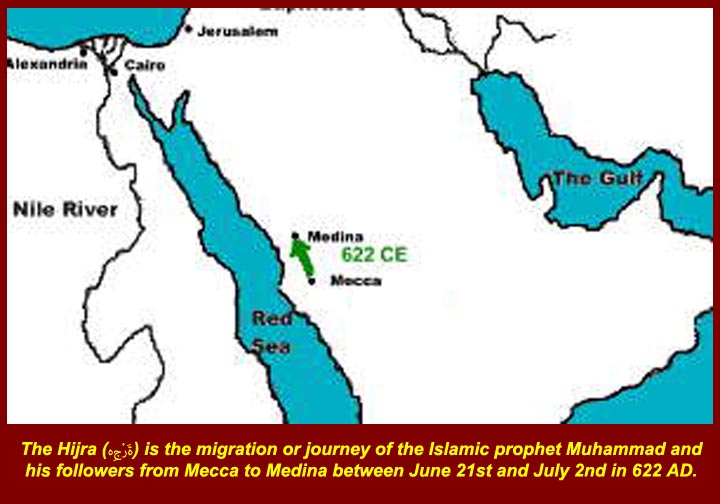
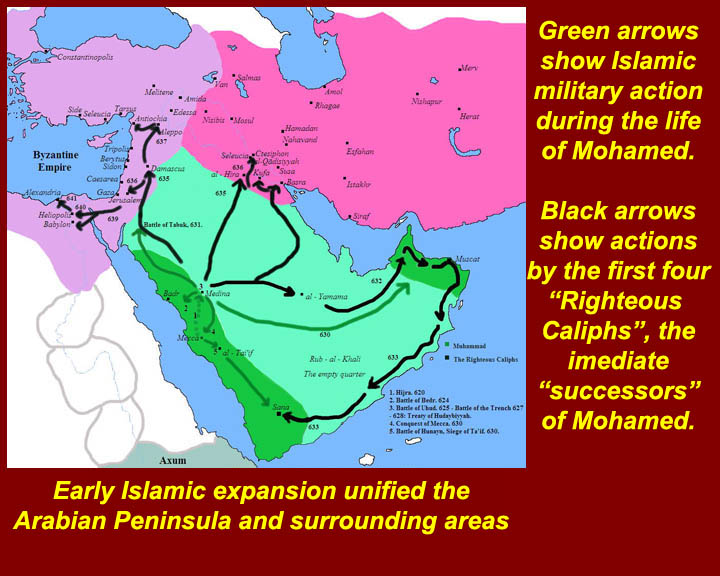
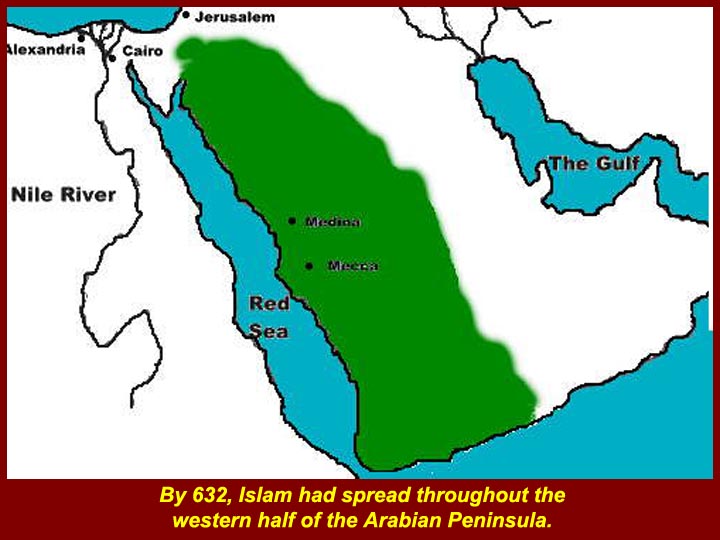
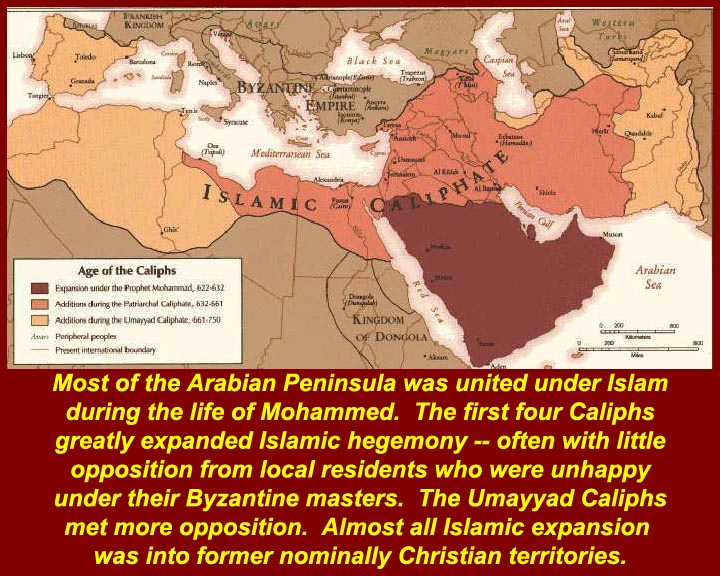
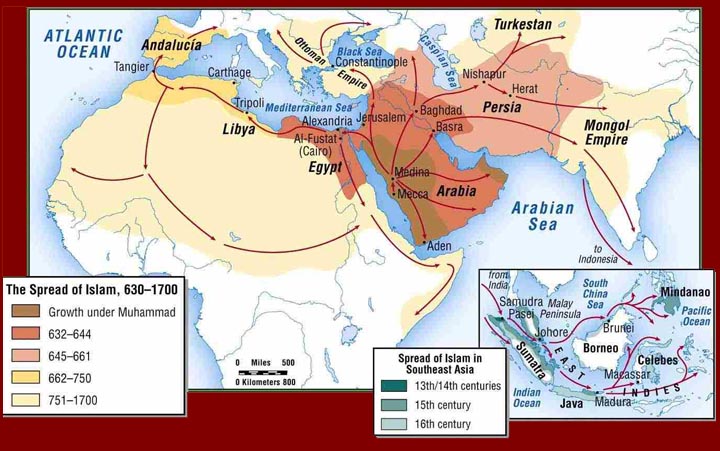
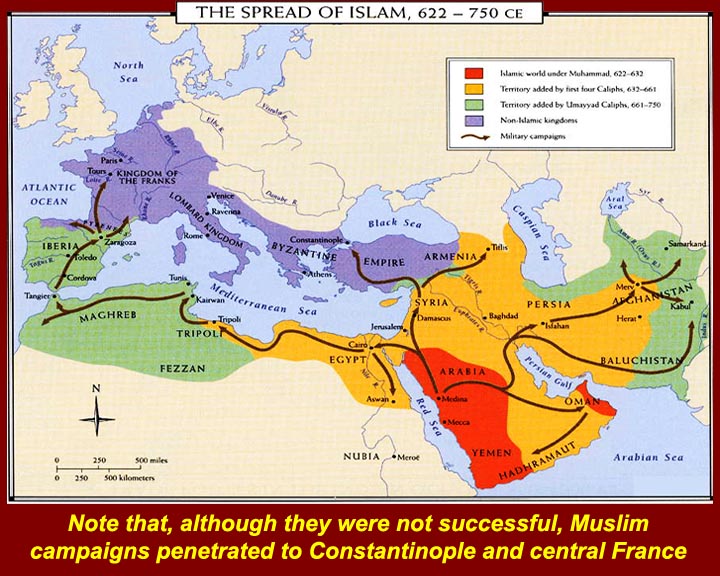
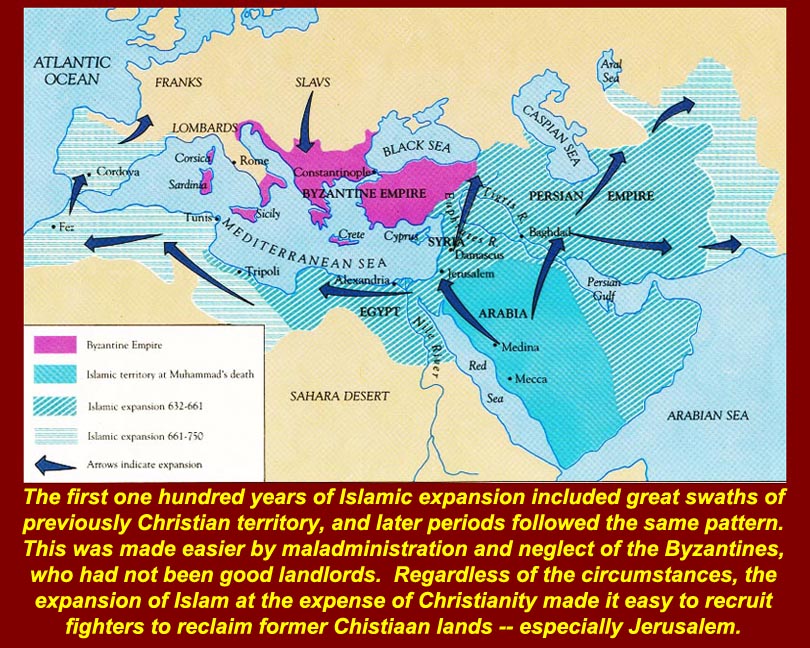
http://www.mmdtkw.org/CRUS0137-Map622.jpg
http://www.mmdtkw.org/CRUS0138-Muslim_Conquest.jpg
http://www.mmdtkw.org/CRUS0139-Map632.jpg
http://www.mmdtkw.org/CRUS0140-IslamExpansionPre750.jpg
http://www.mmdtkw.org/CRUS0141-islam%20spread.jpg
http://www.mmdtkw.org/CRUS0142-IslamSpreadTo750.jpg
http://www.mmdtkw.org/CRUS0143-SpreadOfIslam.jpg

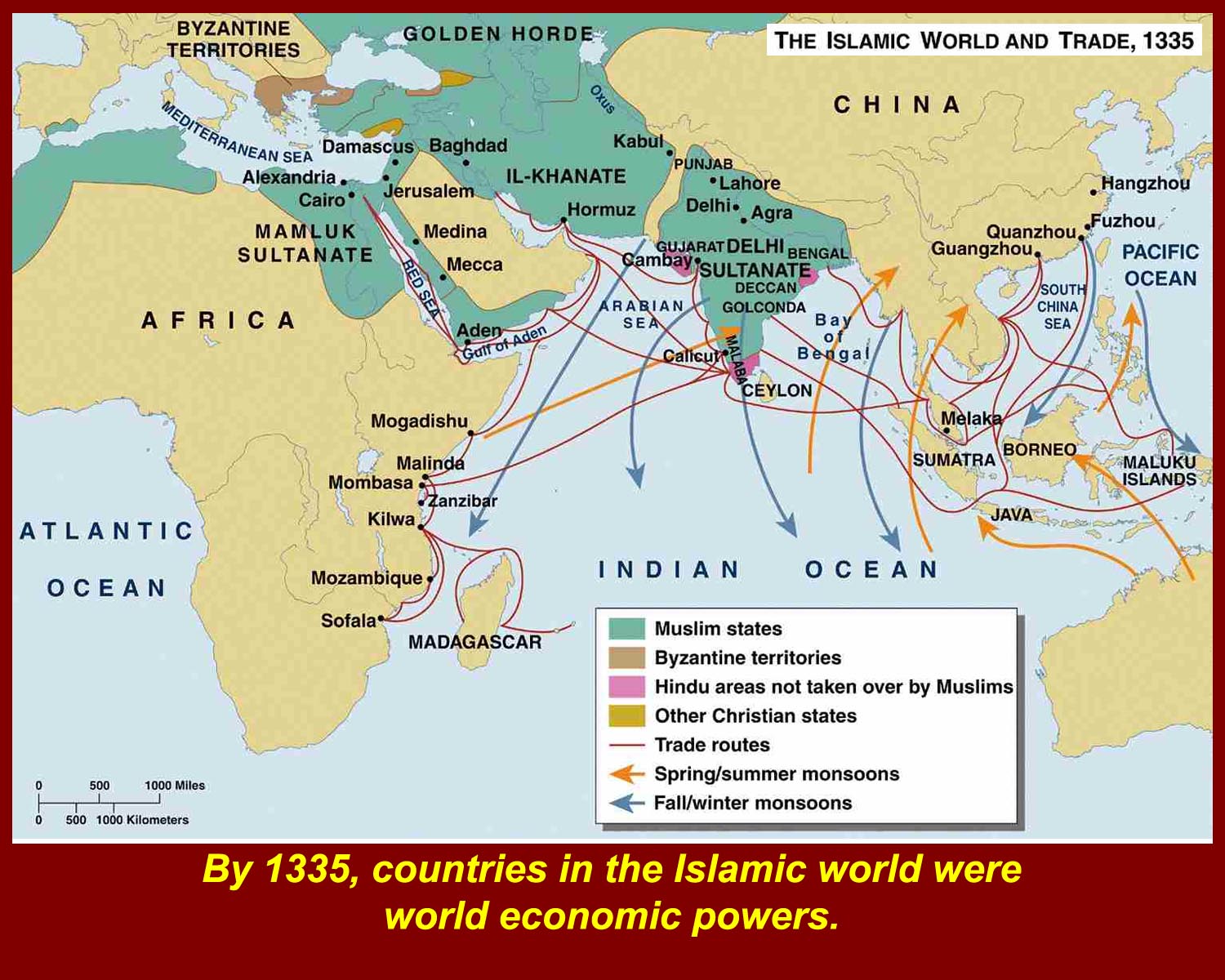
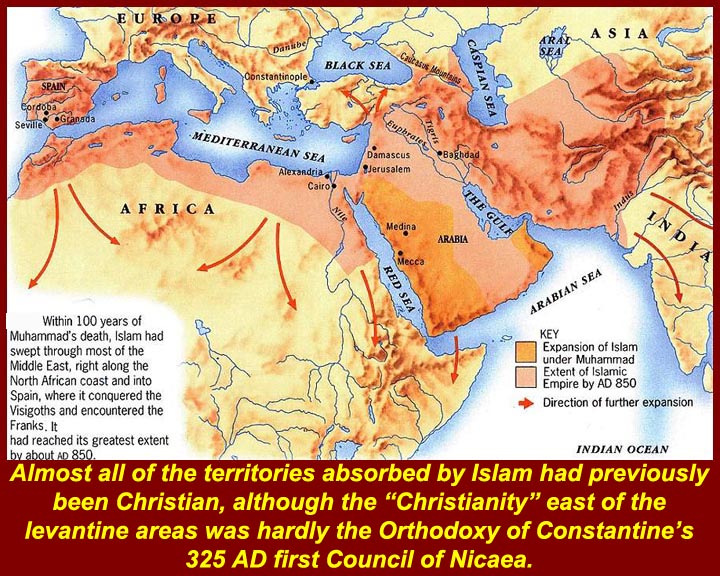
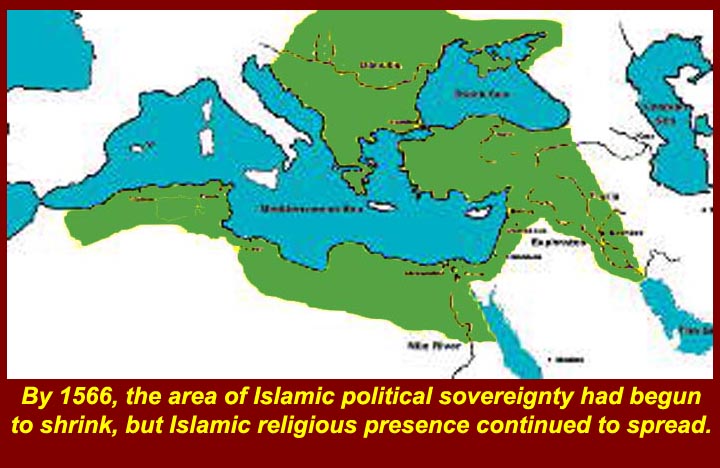
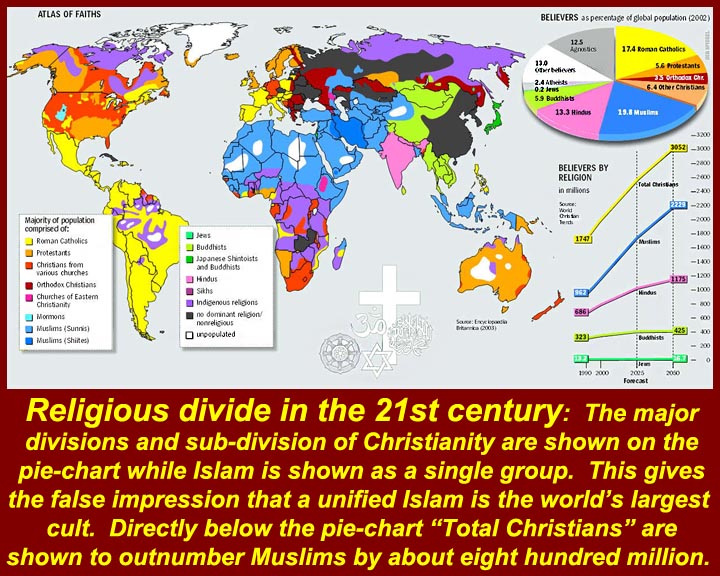
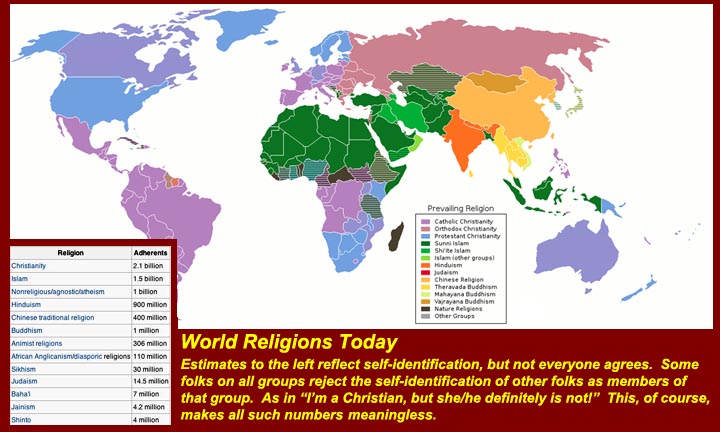
http://www.mmdtkw.org/CRUS0143-SpreadOfIslam.jpg
http://www.mmdtkw.org/CRUS0144-IslamTrade1335.jpg
http://www.mmdtkw.org/CRUS0145-ArabMap.jpg
http://www.mmdtkw.org/CRUS0146-Map1566tn.jpg
http:///www.mmdtkw.org/CRUS0147-IslamReligionSpread.jpg
http://www.mmdtkw.org/CRUS0148-WorldReligionsMap.jpg
Maps show the spread of Islam and of Arab/Turkic conquest.
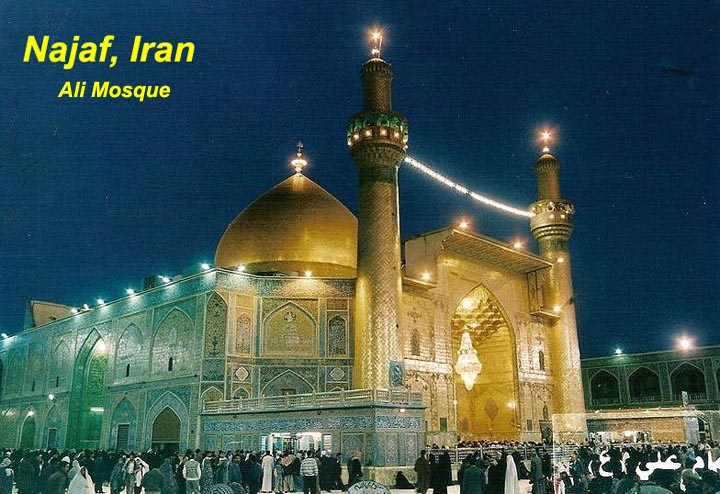
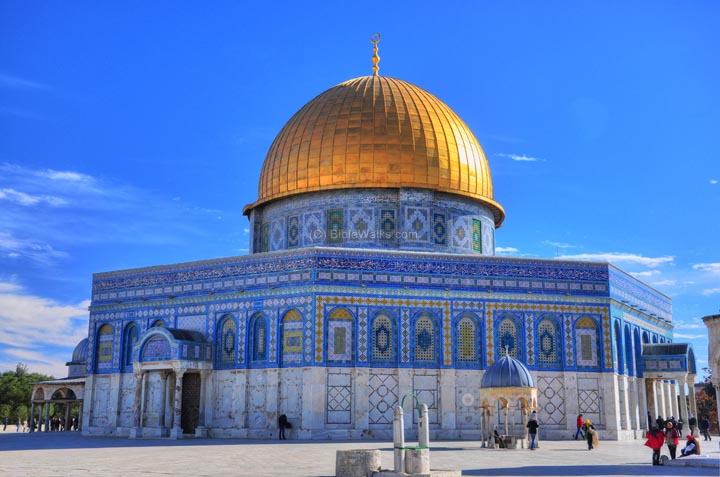
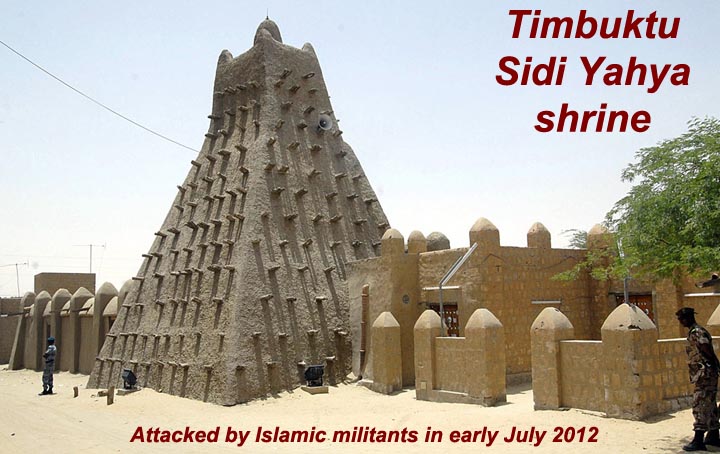

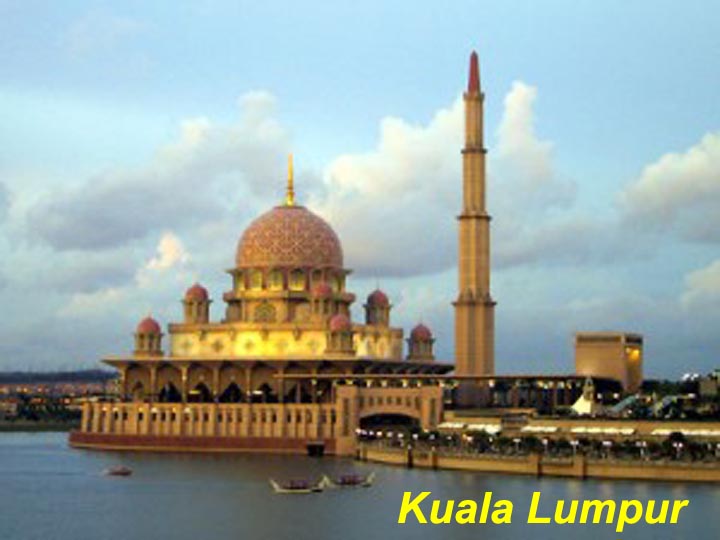
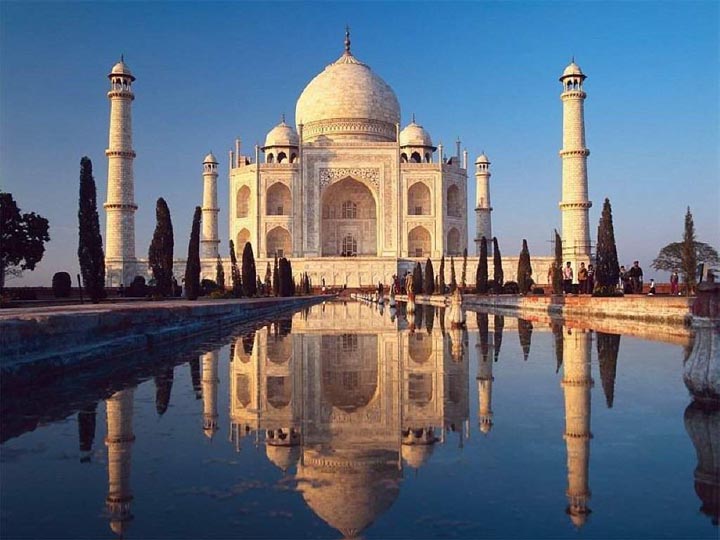
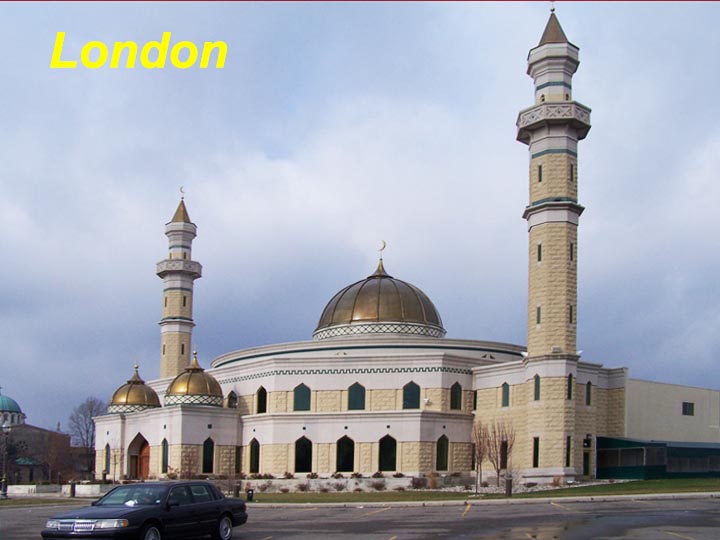
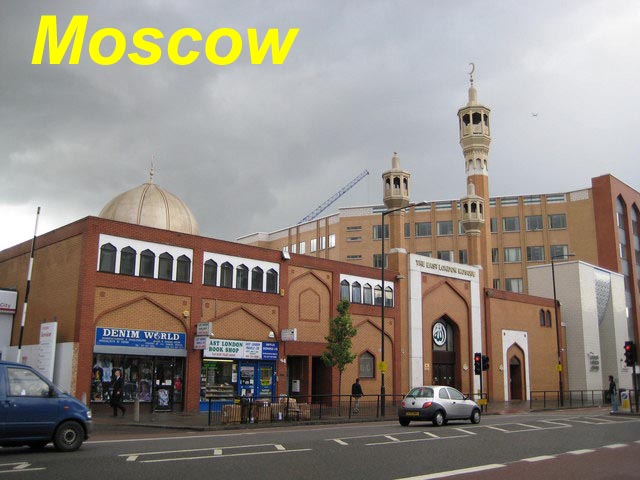
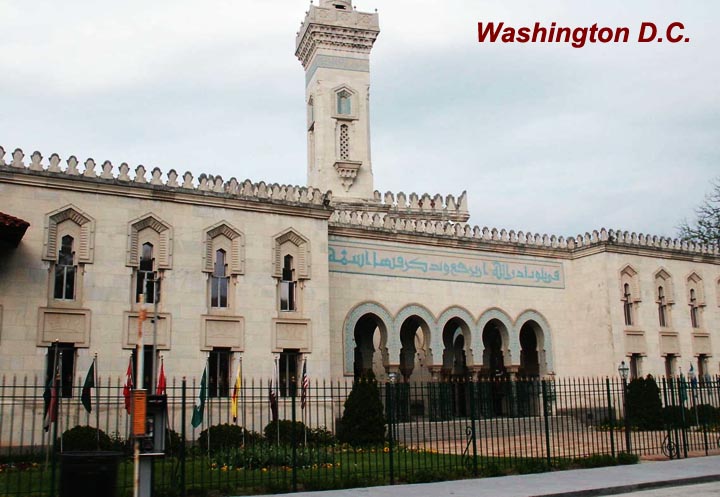
http://www.mmdtkw.org/CRUS0149-AliMosqueNajafIran.jpg
http://www.mmdtkw.org/CRUS0150-JerusalemDomeRock.jpg
http://www.mmdtkw.org/CRUS0151-TimbuktuSidiYahia.jpg
http://www.mmdtkw.org/CRUS0152-Brunei.jpg
http://www.mmdtkw.org/CRUS0153-KualaLumpur.jpg
http://www.mmdtkw.org/CRUS0154-TajMahal.jpg
http://www.mmdtkw.org/CRUS0155-London.jpg
http://www.mmdtkw.org/CRUS0156-Moscow.jpg
http://www.mmdtkw.org/CRUS0157WashingtonDCMosque.jpg
Examples of Islamic mosques and shrines throughout the world.
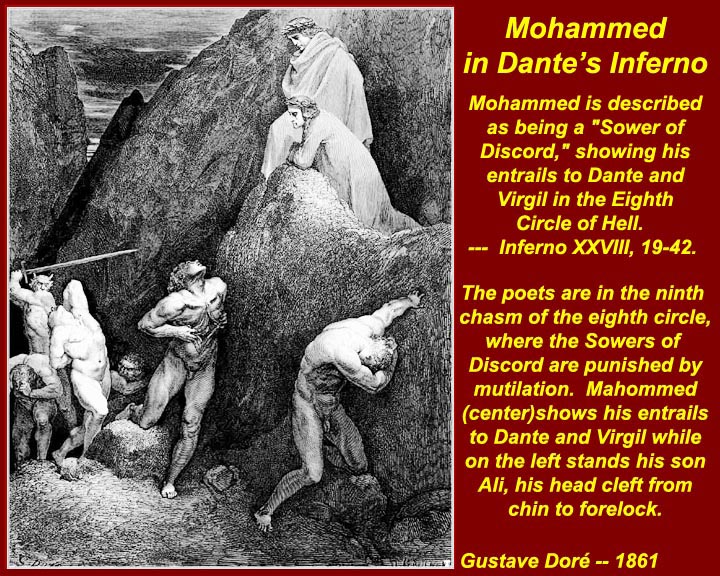
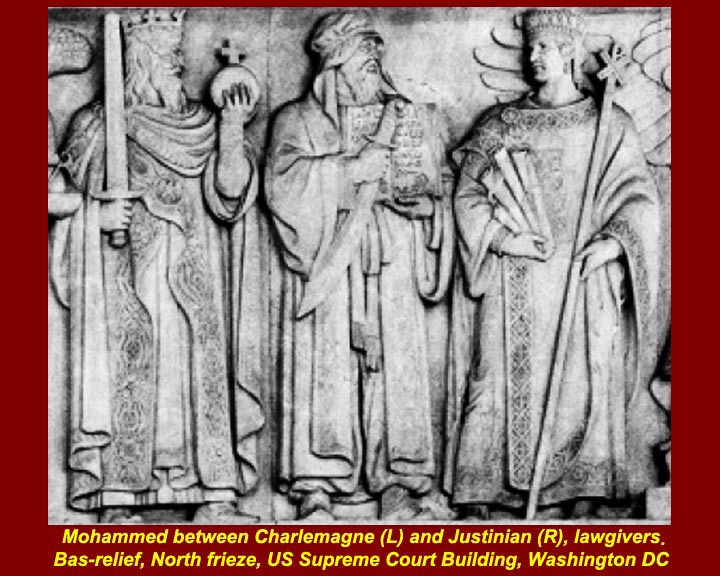
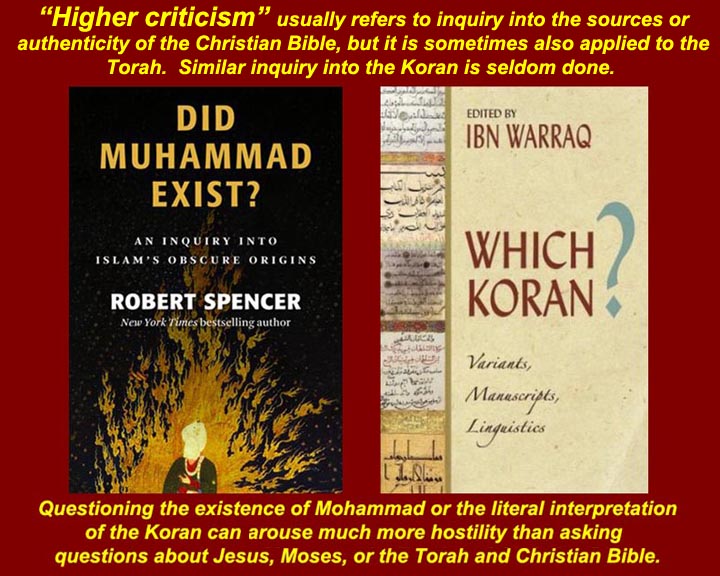
http://www.mmdtkw.org/CRUS0158-GustaveDore-Dante.jpg
http://www.mmdtkw.org/CRUS0159-MohammedScotusnFrieze.jpg
http://www.mmdtkw.org/CRUS0160-QuestioningIslam.jpg
Non-Muslims at various historical historical periods have viewed Islam through their own lenses. Here we have Gustave Dore's 19th century illustration of Mohamed in the ninth trench of the eighth circle of Dante's Inferno. Mohamed, according to Dante, was mutilated for sowing discord.
Next, Mohamed is shown on the "Lawgivers Frieze" of the chamber of the US Supreme Court. For different reasons, some American Muslims as well as some anti-Muslim politicians and commentators have demanded the removal of the image. The Court has decided to keep the frieze as it is.
In the final image are two books, which depending on the viewpoint of the observer, are either anti-Islamic tracts or are "higher criticism" of the Quran and of Islamic traditions. The authors maintain that their books are analogous to works that question the validity of Christian and Jewish holy books and traditions. Christian and Jewish higher criticisms are also received according to the viewpoints of observers.

